Confederate Infantry Guide: Part 1

The following is a comprehensive list of all infantry units in the mod that are currently available to the Confederacy. This guide is intended to not only show what units are available, but to also give players a quick reference to where those units can be recruited from in the mod, the weapons they are equipped with, as well as which faction and generals they are currently assigned to.
This guide is organized according to the type of unit, their home state (in alphabetical order), and their designated number (if applicable).
Infantry
Alabama
6th Alabama Infantry "Raccoon Roughs"
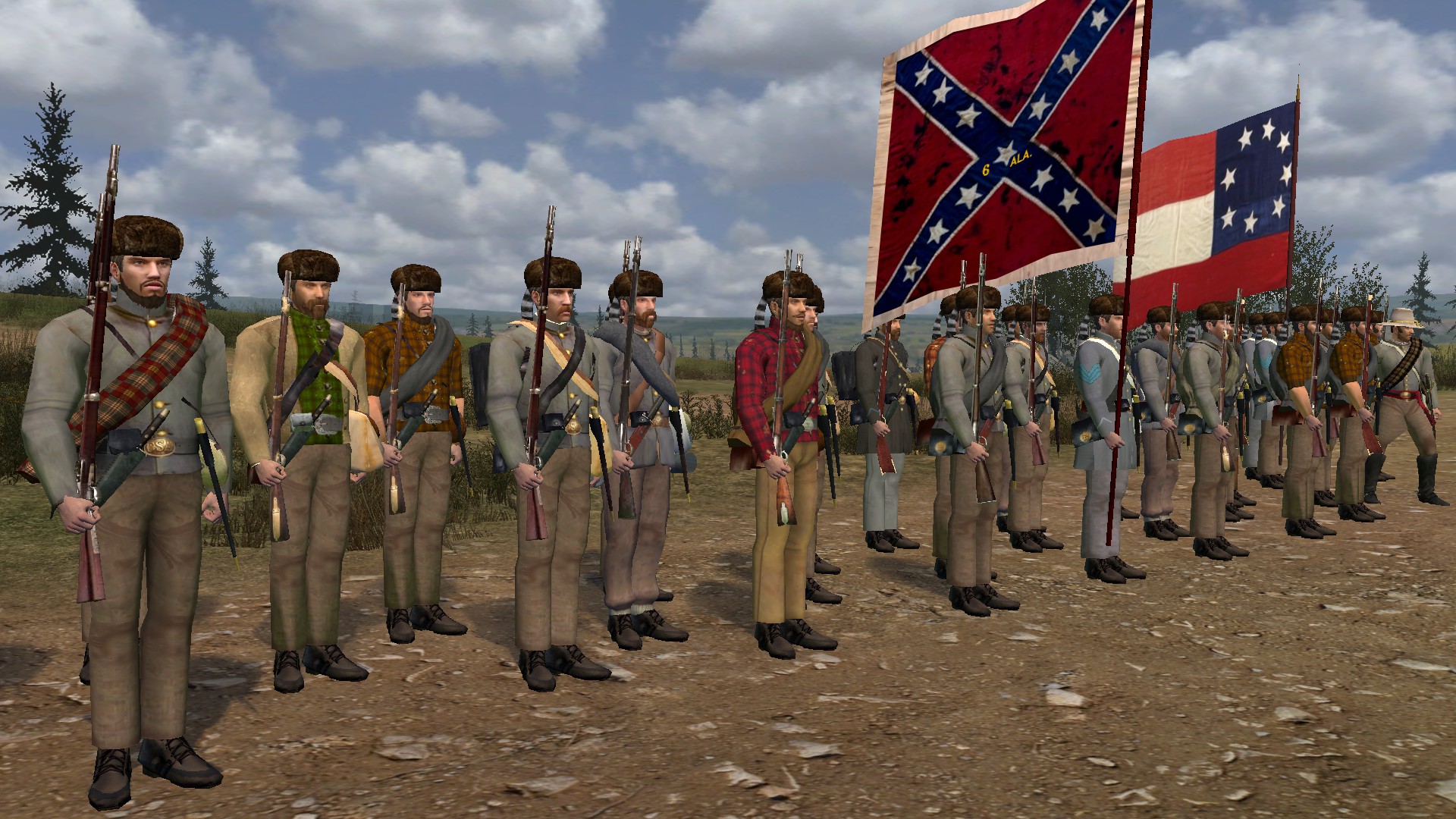
Weapons: (Buck & ball/rifle mix) Springfield Model 1842 Smoothbore Musket, Springfield Model 1816 Flintlock Musket, Springfield Model 1822 Smoothbore Musket, Springfield Model 1835 Smoothbore Musket, Springfield Model 1855 Rifle Musket, M1841 Mississippi Rifle, Kentucky Rifle
Faction: Army of Tennessee
Current Commander: Major General Robert E. Rodes
Recruitment Locations: Montgomery, Pensacola, Fort Stonewall, Fort Pickens, Navarre, Mobile, Selma, Troy, Oxford, Munford, Birmingham, Livingston, Starkville, Talladega, Tuscaloosa
The 6th Alabama Infantry Regiment was organized in Alabama in May of 1861 with 12 companies and about 1,400 men recruited from Autauga, Henry, Jackson, Lowndes, Macon, Montgomery, Russell, and Wilson counties. The regiment fought throughout the Civil War until it was surrendered by Robert E. Lee in April 1865 at Appomattox Court House. Company I of the 6th Alabama Infantry was a mountaineer company known as the "Raccoon Roughs" for their choice of wearing raccoon skin caps.
The 6th Alabama was on the field but was not actively engaged in the Battle of First Manassas (Bull Run), and it passed the fall and winter in that vicinity. The regiment was also present at the Battle of Williamsburg, but never came under fire. At the Battle of Seven Pines, the 6th took a prominent part, losing 102 men killed and 282 wounded out of 632 engaged (59% of the regiment's total strength; their brigade lost 1,296 out of about 2,500). It again took a conspicuous part at the Battles of Mechanicsville, First Cold Harbor, and Malvern Hill. It was then in the advance movement across the Potomac and suffered slight losses at Boonsboro. At the Battle of Antietam (Sharpsburg), the 6th Alabama lost 52 men killed and 104 wounded, and at Fredericksburg, the regiment was again present for duty but was not engaged in the fighting.
The regiment then fought at Chancellorsville, suffering 156 casualties, and capturing a Federal battery flag and 105 prisoners. The 6th went on to participate in the Gettysburg Campaign under the command of Colonel James N. Lightfoot, fighting on Oak Ridge at Gettysburg on July 1st, and at Culp’s Hill on July 2nd and 3rd, suffering 22 men killed, 109 wounded and 31 missing out of 30 officers and 352 men engaged, a casualty total of more than 50% of their strength. Colonel Lightfoot, Major Culver, and Captains John W. Burton and William B. Hunt were wounded, with Burton captured as well.
Having spent the winter near Orange Courthouse, the 6th Alabama was at the Battle of the Wilderness, where it lost considerably, and it suffered even further severe losses at Spotsylvania Court House. Colonel Lightfoot was again wounded in this battle, and Adjutant John Whit Thomas was killed. The regiment's colors were captured by Captain Benjamin F. Davis of the 22nd Massachusetts Infantry Regiment, who was killed shortly afterwards. The regiment took part in the Valley Campaign of General Jubal Early and suffered casualties at Winchester. At the Battle of Cedar Creek, many of the regiment's men were captured. Moving back to Petersburg, it was placed in Fort Mahone and was almost continuously under fire until it surrendered at Appomattox with only 4 officers and 80 men remaining, commanded by Lieutenant Colonel Culver. Of the 2,109 names on its rolls, nearly 400 were killed in battle, and 243 died of disease while in service.
8th Alabama Infantry "Emerald Guards"
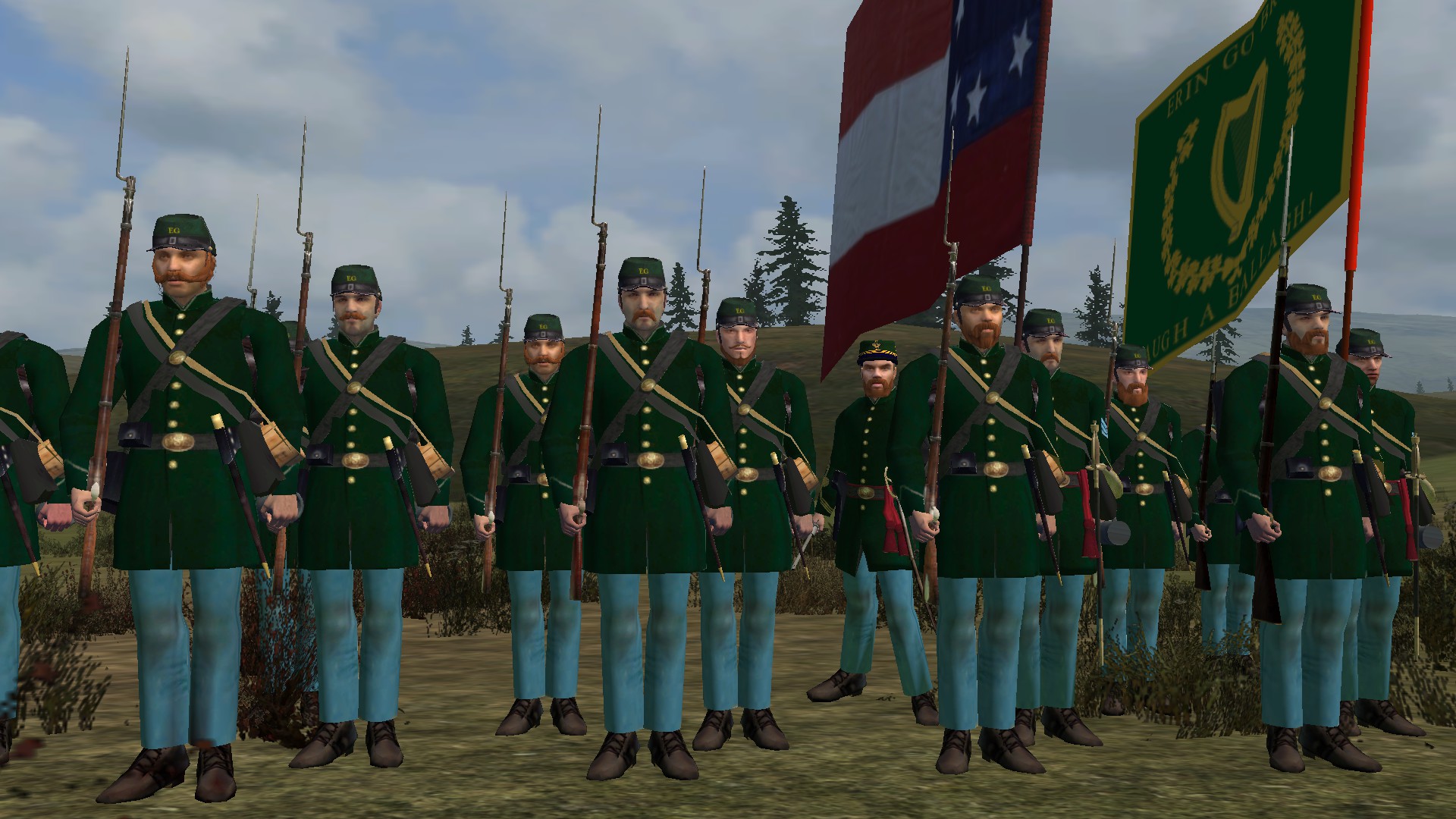
Weapons: Pattern 1853 Enfield Rifle Musket, Springfield Model 1855 Rifle Musket, Springfield Model 1861 Rifle Musket, M1841 Mississippi Rifle
Faction: Army of Northern Virginia
Current Commander: Major General Cadmus M. Wilcox
Recruitment Locations: Montgomery, Fort Stonewall, Mobile, Selma, Troy, Oxford, Munford, Birmingham, Livingston, Starkville, Talladega, Tuscaloosa
The 8th Alabama Infantry formed in Mobile, Alabama and was composed of mostly Irish-born men. At the start of the war, the 8th Alabama, nicknamed the Emerald Guard, wore berdan green uniforms. Their flag was a First National with George Washington in the center. The opposite side of the flag was green, and in the center was an Irish harp surrounded by a wreath of shamrocks. Above and below this emblem, two Gaelic slogans were displayed. The slogans were, "Erin Go Bragh!" (Ireland Forever!) and "Faugh A Ballagh!" (Clear the Way!).
The Emerald Guard was the first Alabama regiment to enlist for the duration of the war. The 8th was organized by the appointment of its field officers by the war department, and was posted at Yorktown, Virginia during the first eleven months of its service. A detachment of the 8th was engaged in a skirmish near Winn's Mill, and then, placed in General Pryor's brigade, the regiment fell back with the army until they were overcome at Williamsburg. The 8th Alabama won its first laurels on that contested field, losing approximately 100 men. At Seven Pines it was again under fire, and received heavy losses, with 32 killed, 80 wounded, and 32 missing.
Now in the brigade of General Wilcox, with the 9th, 10th, 11th, and 14th Alabama Regiments, the 8th took part in a desperate assault with General Longstreet's Division on the enemy's position at Gaines' Mill, and emerged victoriously from the fierce battle with the loss of half of the 350 men it had engaged. Three days later, the regiment was in the line of assault at Frazier's Farm, where the Emerald Guard met Meagher's Irish Brigade, and of 180 effective men, only 90 were at regimental muster the next morning. Its ranks soon began to fill up once more, and the 8th marched with the Confederate army towards the Potomac River. At the Second Battle of Manassas, the 8th Alabama lost 60 men, but was held in reserve. The regiment took part in the capture of Harper's Ferry, then crossed the river and fought fearlessly at Sharpsburg, where the 8th lost 67 men. The Emerald Guards wintered at Rappahannock, and at Salem Church, Wilcox's Alabama Brigade, of which the 8th was a part, bore the brunt of the Union assault, and drove them back in confusion, capturing 1,500 prisoners; the 8th lost 58 men.
General Robert E. Lee led the 8th Alabama and the rest of the Army of Northern Virginia into Maryland, and the 8th's colors were flouted in the face of death at Gettysburg, where 260 of 420 men of the regiment who were engaged, were killed in action. The Army of Northern Virginia crossed the Potomac again, and wintered in the vicinity of Orange Court House. The 8th Alabama was engaged at the Battle of the Wilderness, Spotsylvania Court House, and Cold Harbor. It formed a portion of the troops engaged at the Weldon Railroad, on June 22nd and the 23rd, 1864. The 8th was distinguished at the capture of the Crater on July 30th, and was also warmly engaged in the battle on the plank road below Petersburg. The regiment surrendered with 16 officers and 153 men at Appomattox, and the regimental battle flag, by the end of the war, had two pennants of red and white with tassels and battle honors on them. These were taken home by the regiment's color sergeant, and the flag was ripped up and given to the men, rather than being surrendered.
18th Alabama Infantry
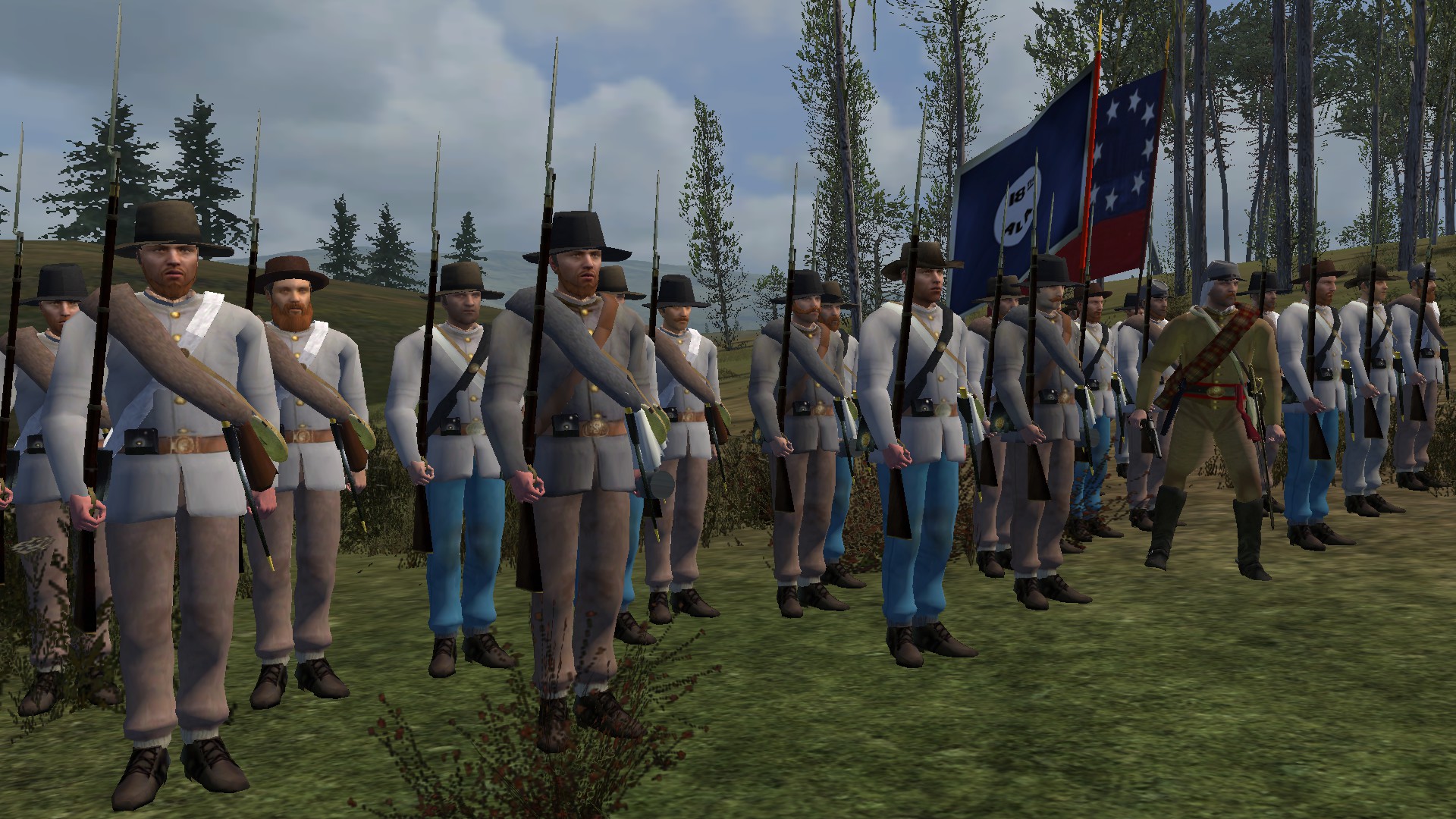
Weapons: Pattern 1853 Enfield Rifle Musket
Faction: Army of Pensacola
Current Commander: Brigadier General John D. Imboden
Recruitment Locations: Montgomery, Pensacola, Fort Stonewall, Fort Pickens, Navarre, Mobile, Selma, Troy, Oxford, Munford, Birmingham, Livingston, Starkville, Talladega, Tuscaloosa
The 18th Alabama regiment was organized at Auburn, Alabama, on September 4th, 1861. The regiment was ordered to Corinth in March 1862, and was there brigaded under General J.K. Jackson with the 17th and 19th Alabama regiments. The 18th Alabama fought the first day at Shiloh and engaged in the severe fighting which resulted in the capture of Union General Benjamin Prentiss' division, and was ordered by General Wheeler to carry the prisoners to Corinth. It did not take part the second day. After the battle, the regiment had lost 125 men killed and wounded out of 420 men engaged.
The 18th Alabama went on to fight at Farmington, Mississippi, and was prominent in the battle of Chickamauga. The 18th was terribly mutilated in this battle, losing 300 men killed and wounded, out of 500 men engaged, and 22 out of 36 officers. At Chattanooga, the regiment arrived near the Rossville Gap, and the 18th took positions as skirmishers in part of the old breast works the Union troops had abandoned after the Battle of Chickamauga. The brigade was then split into several segments for deployment along the ridge and at Rossville Gap. About 45 minutes following their arrival, Union troops appeared on the ridge, and when the 18th gave way at the skirmish line, Clayton's men had attempted to form in line of battle. However the 36th and 38th Alabama regiments broke and ran through the brigade line, creating much confusion.
The 18th Alabama was engaged at Missionary Ridge on November 25th, 1863, and lost about 90 men in the battle, mostly captured, and their Hardee pattern flag was captured by the 13th Illinois. It participated in all the subsequent battles of the army of Tennessee and was distinguished in the Dalton and Atlanta campaign. After spending the winter at Dalton, it began the Dalton-Atlanta campaign with 500 effective men, and fought all the way to Jonesboro, losing constantly in killed and wounded, but with no severe loss at any one place. By the end of the campaign, it had lost nearly half its number. The regiment went on to fight in the battles in front of Dalton, and then Rocky Face from May 7th to the 12th. With 2 killed, 4 wounded, and 7 missing, the 18th Alabama regiment left Rocky Face Mountain the night of May 12th.
The 18th arrived at Resaca the evening of May 13th. On the 14th they commenced entrenching, and the regiment was engaged on the 14th and 15th in advancing their lines. In charges against the 5th Indiana Light Artillery, the battle flag with crossed cannons and battle honors were captured by the 5th Indiana. The regiment left the night of the 15th with 1 officer and 5 men killed, 41 wounded, and 27 missing. The 18th arrived at Cassville on the evening of May 17th, and the next day three companies including Company G were sent out as skirmishers. They were engaged for about an hour when they finally retired, losing 33 men missing. The regiment left Cassville the evening of the 18th and marched to New Hope Church.
At 10:00 a.m. on May 25th, the 18th Alabama with 2 other regiments threw up log breastworks, while the 32nd Alabama and the 58th Alabama went to hold the road from the enemy. Clayton ordered Captain Darby of the 18th Alabama to move forward with a line of skirmishers replacing the 32nd and 58th Alabama. At 5:00 p.m. they were engaged for over two and a half hours. Eventually the skirmishers were driven back, and the Union soon made their appearance in force, engaging the whole line. At daylight on May 26th, the 58th Alabama relieved the 18th at the trenches. May 27th the 18th relieved the 58th in return at the trenches, the enemy again attacked Clayton's Brigade in the same position, but was repulsed. They withdrew the morning of May 28th, with 4 officers wounded, 4 men killed, 43 wounded, and 2 missing. On the 27th, the 18th Alabama regiment was under fire from sharpshooters and artillery, and lost 1 officer wounded, 2 men killed and 4 wounded.
The regiment went on to fight at Pickett’s Mill, Peachtree Creek, Atlanta, Jonesboro, and Lovejoy’s Station. The regiment went with General Hood into Tennessee, and lost about 100 at Franklin, most of whom were captured, and participated in the Battle of Nashville. When the army moved to the Carolinas in February 1865, the regiment was ordered to Mobile, and placed in the field works at Spanish Fort from March 26th to April 8th, 1865. The 18th Alabama participated prominently in the siege several weeks later, with some loss, and escaped when the defenses were evacuated. The regiment finally surrendered at Meridian, Mississippi on May 4th, 1865.
31st Alabama Infantry
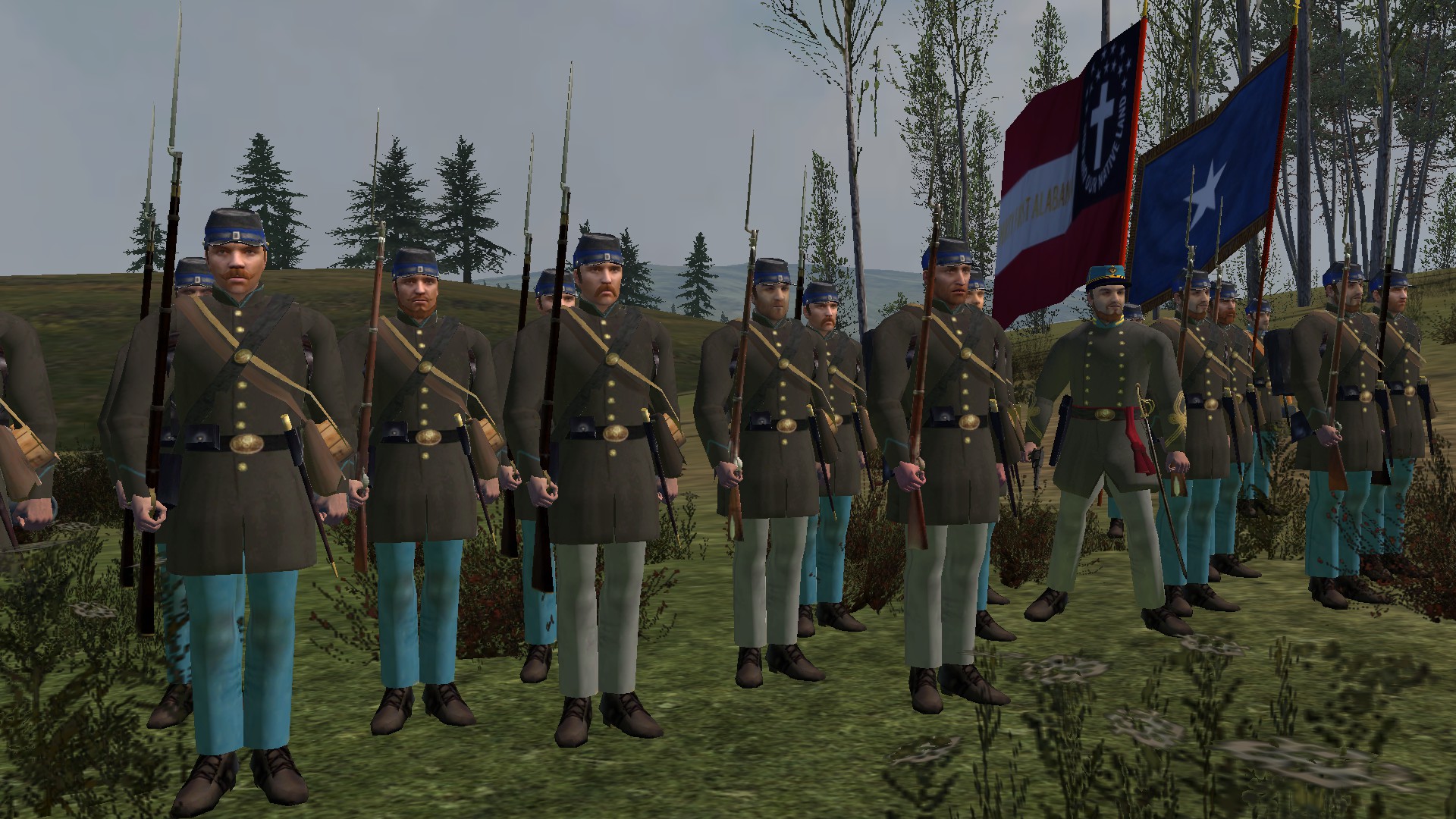
Weapons: Pattern 1853 Enfield Rifle Musket, Springfield Model 1855 Rifle Musket, Springfield Model 1861 Rifle Musket, Springfield Model 1863 Rifle Musket
Faction: Army of Tennessee
Current Commander: Lieutenant General John C. Pemberton
Recruitment Locations: Montgomery, Pensacola, Fort Stonewall, Fort Pickens, Navarre, Mobile, Selma, Troy, Oxford, Munford, Birmingham, Livingston, Starkville, Talladega, Tuscaloosa
The 31st Alabama Infantry Regiment was organized at Talladega, on the 16th of March, 1862, with men from Calhoun, Cherokee, Montgomery, Randolph, Shelby, and Talladega counties. It reported to General Danville Leadbetter at Chattanooga shortly after. It then moved up to Knoxville, where it was brigaded under General Seth Barton, in Carter Stevenson's Division. Men often enlisted in a company recruited in the counties where they lived though not always. After many battles, companies might be combined because so many men were killed or wounded. The regiment took part in the fight at Cumberland Gap and Tazewell but was not engaged when it moved into Kentucky.
The regiment was ordered to Mississippi and permanently brigaded with the 20th, 23rd, 30th, and 46th Alabama, under the command of General Edward D. Tracy. The 31st went on to fight at the battles of Chickasaw Bayou, Port Gibson, Champion's Hill, and Vicksburg. In December, the 31st Alabama accompanied Stevenson's Division to Vicksburg. In May 1863 the regiment was initiated into the sternest duties of war, helping to defend Port Gibson, Mississippi, where the regiment suffered severely. The regiment went on to fight at Baker's Creek, and the losses they sustained there were very heavy. As part of the garrison of Vicksburg, the regiment shared in the dangers and privations of that siege, and, after losing a number killed and wounded, was surrendered with the fortress. Losses to the 31st at Vicksburg were 21 killed in action, and 37 wounded. Placed in parole camp at Demopolis, the 31st was soon exchanged and reorganized under the brigade of General Edmund Pettus, going on to participate in many of the battles of the Army of Tennessee. The regiment was engaged with slight loss at Mission Ridge, wintered at Dalton, and participated in the campaign from Dalton to Atlanta, having a full share in the dangers and hardships which have made the 31st a bloody but proud page in history.
The regiment followed General John Bell Hood into Tennessee and sustained severe losses at Columbia and Nashville, and served as the rear guard of the retreating army. Transferred to North Carolina, the regiment was hotly engaged at Bentonville, and a fragment of the 1,100 with which it entered the service surrendered at Greensboro, as part of Pettus' Brigade. Only 180 men were fit for duty in January 1865, and less than 100 surrendered in April. Toward the close of the war, the 31st was consolidated with the 23rd and 46th Infantry and re-designated the 23rd Consolidated Infantry Regiment at Smithfield, on the 9th of April, 1865.
Arkansas
5th Arkansas Infantry "Fighting Fifth"
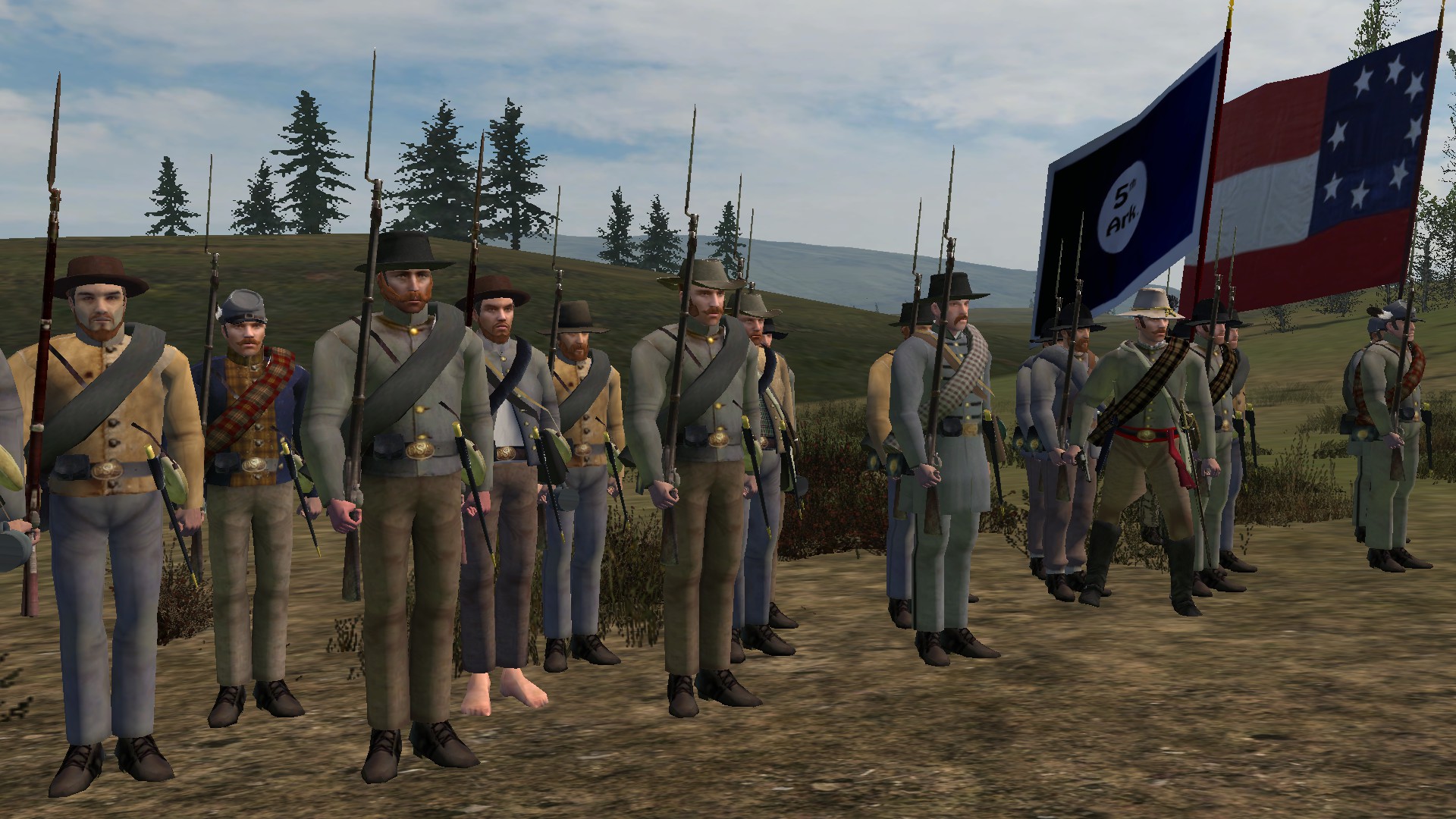
Weapons: (Buck & ball) Springfield Model 1816 Flintlock Musket, Springfield Model 1822 Smoothbore Musket
Upgrades to: Springfield Model 1861 Rifle Musket, Springfield Model 1855 Rifle Musket, Pattern 1853 Enfield Rifle Musket, Lorenz Rifle Model 1854
Faction: Army of Tennessee
Current Commander: Major General Thomas C. Hindman
Recruitment Locations: Jackson, New Orleans, Houston, Vicksburg, Corinth, Memphis, Little Rock, Shreveport, Alexandria LA, Greenville, Blair's Landing, Paducah, Pea Ridge, Corpus Christi, Hammond
After Arkansas seceded from the Union on May 6th, 1861, a number of military units began to form. Companies organized in communities around the state and moved to a number of centralized locations to create regiments. Ten companies from across Arkansas formed the 5th Arkansas Infantry, also called the "Fighting Fifth", and was organized for one year in state service at Gainesville in Greene County, Arkansas, on June 28th, 1861, and was transferred to Confederate service on July 27th, 1861, at Pocahontas, Arkansas. The first colonel of the regiment was David Cross, a planter from Poinsett County. It was reorganized for the war at Corinth, Mississippi, on May 12th, 1862. The regiment was armed with weapons which the state confiscated when the Federal Arsenal at Little Rock was seized by Arkansas State Militia troops in February 1861. Disposition of the weapons found in the Arsenal is somewhat sketchy, but from various records it can be surmised that the 5th, 6th, 7th, and 8th Arkansas Infantry Regiments, mustered in June, 1861, were issued Springfield Model 1816 and Model 1822 .69 caliber muskets. They retained these weapons until April, 1862 when they were able to exchange them for better weapons scavenged from the battlefield at Shiloh.
In October, the regiment moved to the east bank of the Mississippi River, where it would serve for the remainder of the war. Joining a brigade under the command of Brigadier General Sterling Alexander Martin Wood, the 5th served alongside the 7th and 8th Arkansas Infantry regiments, the 9th Arkansas Infantry Battalion, and other units from Mississippi, Georgia, Alabama, and Tennessee. The brigade was part of the Central Army of Kentucky under the command of Major General William Hardee. After the losses of Fort Henry and Fort Donelson in February 1862, Confederate General Albert Sidney Johnston withdrew his forces into western Tennessee, northern Mississippi, and Alabama to reorganize, and then retreated through western Tennessee to northern Mississippi.
The 5th Arkansas joined a new brigade under the command of Brigadier General Thomas C. Hindman, which also included the 2nd, 6th, and 7th Arkansas Infantry Regiments and the 3rd Confederate Regiment. The 5th Arkansas did not participate with the brigade at the Battle of Shiloh, as it was on picket duty along the Memphis and Charleston Railroad, about 7 miles north and west of Corinth, Mississippi. Colonel David C. Cross had pleaded with General Albert Sidney Johnston to permit the 5th Arkansas to take part in the movement towards Shiloh, but Johnston replied that, "the post of duty was the post of honor," and kept the 5th Arkansas on picket duty. After the battle, the Confederate army reorganized, and Cross was not reelected as colonel of the regiment. He was replaced by Lucius P. Featherston, formerly the inspecting and muster officer for the regiment.
In early May 1862, Confederate forces underwent an army-wide reorganization due to the passage of the Conscription Act by the Confederate Congress in April 1862. All of the 12 month regiments had to re-muster and enlist for two additional years or the duration of the war; a new election of officers was ordered, and men who were exempted from service by age or other reasons under the Conscription Act were allowed to take a discharge and go home. Officers who did not choose to stand for re-election were also offered a discharge. The reorganization was accomplished among all the Arkansas regiments in and around Corinth, Mississippi, following the Battle of Shiloh. When Corinth was evacuated on the approach of Union Generals Halleck and Grant in May 1862, the regiment fell back with the Confederate army to Tupelo Mississippi, where it was reorganized. Captain Lucius Featherston was elected colonel, John E. Murray, Lieutenant Colonel, and Captain Peter Green, major; J. J. Winston was appointed adjutant.
The 5th Arkansas saw action for the first time at the Battle of Perryville in Kentucky on October 8th, 1862, losing four men killed. With the promotion of Thomas Hindman to the rank of major general, General St. John Liddell took command of the brigade and led it in the Kentucky Campaign. The regiment, organized with 722 officers and men, participated in the Battle of Murfreesboro, Tennessee, from December 31st 1862 – January 2nd, 1863, where it lost 42% of the 336 men from the regiment that were engaged, with 12 men killed, 135 wounded, and one man missing. The 5th next saw action in the Tullahoma Campaign, where the regiment lost 8 killed and 14 wounded at the Battle of Liberty Gap. In the summer of 1863, the 5th Arkansas was consolidated with the 13th Arkansas. At the Battle of Chickamauga in September, the regiment lost 38 men killed, 131 wounded, and 33 missing. Included in the dead was Featherston, who was killed in the first day of the battle. He was succeeded in command by Murray, who was promoted to colonel. Participating in the Chattanooga Campaign, the regiment had 21 men disabled at the Battle of Ringgold Gap.
The regiment next helped defend Atlanta, Georgia, participating in the Battles of Resaca, Pickett’s Mill, New Hope Church, and others. Colonel Murray was killed at the Battle of Atlanta on July 22nd, and Lieutenant Colonel Peter Green took command of the regiment until the end of the war. The regiment lost 17 killed in the battle. Part of the regiment was captured at the Battle of Jonesboro on September 1st, but the soldiers were soon exchanged. The regiment and the rest of Govan's Brigade participated in General John Bell Hood's disastrous Franklin-Nashville Campaign. Due to the appalling losses suffered by Govan's Brigade during the Atlanta Campaign, the 1st/15th, 5th/13th and 2nd/24th Arkansas Regiments were consolidated into one regiment, which was commanded by Colonel Peter Green of the 5th/13th Arkansas (specifically of the 5th). The consolidated regiment fought under the colors of the consolidated 5th/13th Arkansas Regiment, because this was one of the only colors not captured when Govan's Brigade was overrun at the Battle of Jonesboro. The flag of the combined 5th/13th Arkansas was issued in March 1864 and was captured by Benjamin Newman of the 88th Illinois Infantry at the Battle of Franklin. The consolidated regiment numbered just 300 rifles in total, and sustained 66% casualties at Franklin.
Green took command of the brigade when General Daniel Govan was wounded, and Lieutenant Colonel E. A. Howell took command of the regiment. The consolidated 6th and 7th Arkansas Infantry regiments were added to the unit on March 15th. After the Battle of Bentonville in March 1865, the regiment underwent one final consolidation. The remnants of ten depleted Arkansas regiments, along with one mostly Arkansas regiment, in the Army of Tennessee were consolidated into a single regiment at Smithfield, North Carolina, on April 9th, 1865. The 1st Arkansas was lumped together with the 2nd, 5th, 6th, 7th, 8th, 15th, 19th and 24th Arkansas Infantry Regiments and the 3rd Confederate Infantry Regiment as the 1st Arkansas Consolidated Infantry. The 5th Arkansas made up one company in this new regiment. On April 26th, 1865, the 1st Arkansas Consolidated Infantry Regiment was present with the Army of Tennessee when it surrendered in Greensboro, North Carolina. A little over 100 men, all that remained of the 5th Arkansas, were paroled.
Florida
1st Florida Infantry
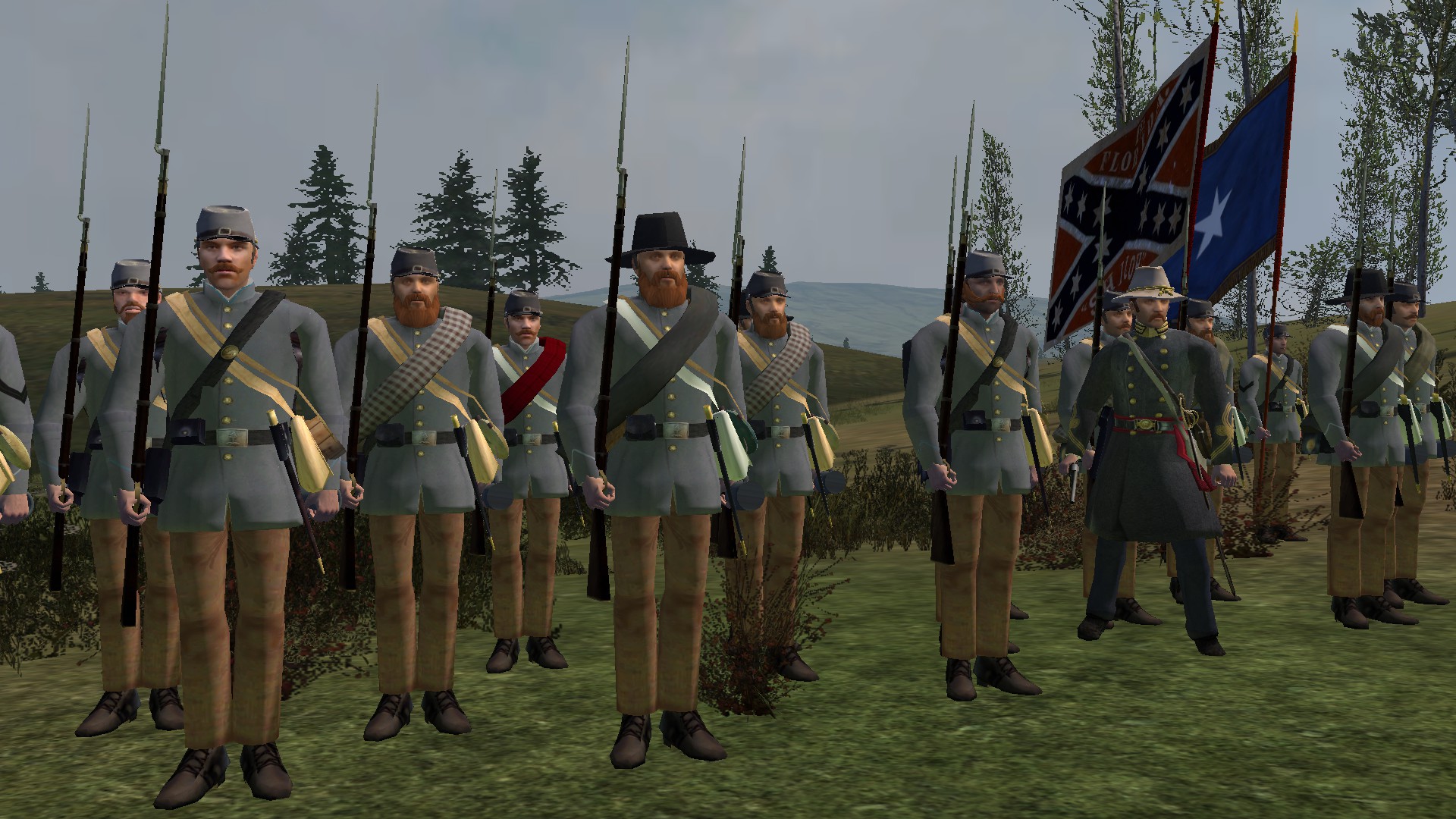
Weapons: Pattern 1853 Enfield Rifle Musket
Faction: Army of Pensacola
Current Commander: Major General William H.C. Whiting
Recruitment Locations: St. Augustine, Tallahassee, Pensacola, Atlanta, Savannah, Fort Wagner, Calhoun, Augusta, Fort Ward, Fort Pickens, Fort Marion, Macon, Navarre, Brunswick, Tampa, St. Marks, Madison, Olustee, Gainesville, Jacksonville, Murphy, Athens, Livingston, Cedar Shoals
At the beginning of the Civil War in 1861, the state of Florida rushed to raise a regiment of infantry. In March, at Chattahoochee Arsenal, men from the counties of Leon, Alachua, Madison, Jefferson, Jackson, Franklin, Gadsden, and Escambia assembled, and on May 5th, 1861, the 1st Florida Infantry Regiment was mustered into state service. However, due to the haste with which the regiment was formed, it suffered from an insufficient number of uniforms and weapons to equip all 700 men of the regiment's 9 companies. Upon completion of the regiment's organization, it was ordered to Pensacola, where it was mustered into Confederate service on April 19th.
On October 9th, 1861, a detachment of 180 men from the 1st Florida participated in the unsuccessful attempt to capture Fort Pickens. Colonel James P. Anderson led a column with his Floridians as well as men from Louisiana and Alabama, and the regiment lost 7 dead, 8 wounded and 12 men captured in the fighting. The 1st Florida Infantry then joined General Braxton Bragg on his journey west in March 1862, and went to Corinth. Like all regiments mustered in the early days of 1861, the 1st Florida had only enlisted for twelve months. When these 12 months were finished in early 1862, the regiment failed to reorganize when only 300 of the remaining 600 men reenlisted. Those 300 men were organized into four companies under the command of Major McDonnell, and the 1st (McDonell's) Florida Infantry Battalion, as it was now known, were just in time for the Battle of Shiloh.
On April 6th, 1862, 250 men of the 1st Florida were present and participated in the morning advance as part of the second line. Advancing along the Pittsburgh-Corinth Road, the regiment suffered under heavy fire from Ohio troops and artillery. When Major McDonell fell wounded by an artillery fragment, the command of the regiment passed to Captain William G. Poole. Anderson's brigade, including the 1st Florida, commanded by the regiment's former colonel, were part of the force that stormed the Hornet's Nest. The exhausted Confederate troops were periodically bombarded through the night by Union gunboats, and eventually retreated with the rest of the army on April 7th. Poole, turning over command to Captain W.C. Beard on the 7th, was cited by Anderson for his gallant leadership throughout the two day battle. The battalion lost 14 dead and 57 wounded at Shiloh, and was afterwards consolidated with the Confederate (Louisiana) Guards Response Battalion under overall command of Major William Clack, however this consolidation proved to be only temporary, as the Guards Battalion was transferred in August 1861.
Going north as part of the Confederate Heartland Offensive, the 1st Florida Battalion fought in the Battle of Perryville, suffering 12 dead, 54 wounded and 6 missing from a total of 167 men. After the battle, the depleted battalion was consolidated with the 3rd (Miller's) Florida Battalion. Miller's 6 companies and the veterans of the 1st Florida were reorganized as the 1st Florida Infantry Regiment once again, and William Miller was elected Colonel. The 531 men of the 1st Florida Infantry, loosely paired with the 3rd Florida Infantry fought with distinction at the Battle of Stones River, taking high losses including Colonel Miller, who was wounded on the last day of the battle. Overall command then went to Colonel William S. Dilworth of the 3rd Florida. Due to the casualties both regiments received, this consolidation became permanent; Dilworth stayed in command for the rest of the war while Miller commanded reserve forces.
In March 1863, the The 1st-3rd Florida saw combat around the siege of Vicksburg. Detached to participate in the Jackson Expedition, General Joseph Johnston's relief action, it fought as part of Adams' brigade in the Siege of Jackson. At the Battle of Chickamauga, the 1st-3rd Florida was detached from General John C. Breckinridge's division with an artillery battery as observation force, stationed near Glass' Mill. During the night, D.H. Hill's whole corps was shifted to the extreme right of the Confederate line, and the 1st-3rd Florida, relieved by cavalry from Wharton's division, had to march through the night until it reached its position on the right; not locating its brigade until 8:00 a.m. When the advance against Horseshoe Ridge started in the morning, the brigade marched against elements of George H. Thomas' XIV Corps. Advancing towards Kelly Field along the Lafayette Road, the 1st-3rd Florida, together with the 47th Georgia Infantry, was separated from the rest of the column and drifted towards the right. Here it faced elements from King's Regular Brigade, where it nearly lost its colors during the retreat and reunited with their brigade after King's brigade was repulsed. The division then shifted its northern elements to the east due to the advance of Gordon Granger's Reserve Corps from the north. Another advance towards Kelly Field in the afternoon brought in a number of Union prisoners, but failed to break the Union lines. By the end of the action at Chickamauga, the 1st-3rd Florida lost 9 men killed, 70 wounded and 13 missing. 18 of the regiment's men were later put on the Confederate Honor Roll.
In early November, the Army of Tennessee was still besieging Union forces at Chattanooga, where the federals retreated after Chickamauga. All infantry units from Florida were gathered together into one brigade. The Florida Brigade consisted of the 1st-3rd, 4th, 6th and 7th Florida Infantry Regiments, as well as the 1st Dismounted Florida Cavalry. At the Battle of Missionary Ridge, the brigade was stationed next to General Braxton Bragg's headquarters, half in the second line and half in the forward position below the crest. As the Confederate army was overwhelmed by the reinforced Union troops, it tumbled out of position, and parts of the brigade fought in General William B. Bate's makeshift rear-guard. In the beginning of the Atlanta Campaign in early 1864, the hardships of winter and constant marches took its toll. At the Battle of Resaca, the 1st-3rd Florida regiment had to endure its worst artillery barrage during the war. Later in the campaign, during the Battle of Marietta, the 1st-3rd Florida had just 120 men ready for duty. The regiment was present when corps commander General Leonidas Polk was killed. Colonel Dilworth was asking the General to seek cover only seconds before he was hit by an artillery shell.
At the Third Battle of Murfreesboro, the Floridians lost their acting brigade commander, Colonel Robert Bullock, and were forced to give way. The numerically inferior and unsupported brigade was pushed back for nearly a mile before the Union troops stopped them. After the retreat from Nashville, the six small Florida regiments were sent to North Carolina where they fought one more battle at Bentonville, on March 19th, 1865. On the same day that General Robert E. Lee surrendered in Virginia, General Joseph E. Johnston reorganized his army. The Western Florida Brigade was consolidated and their six regiments were put into a single unit, being the last form of the 1st Florida Infantry Regiment. When Johnston surrendered at Bennett Place on April 26th, the 1st Florida, and with them all Floridian units in the Army of Tennessee, had fewer than 200 men present and fit for duty, with just over 400 total. The troops were paroled on May 1st, 1865.
7th Florida Volunteer Infantry
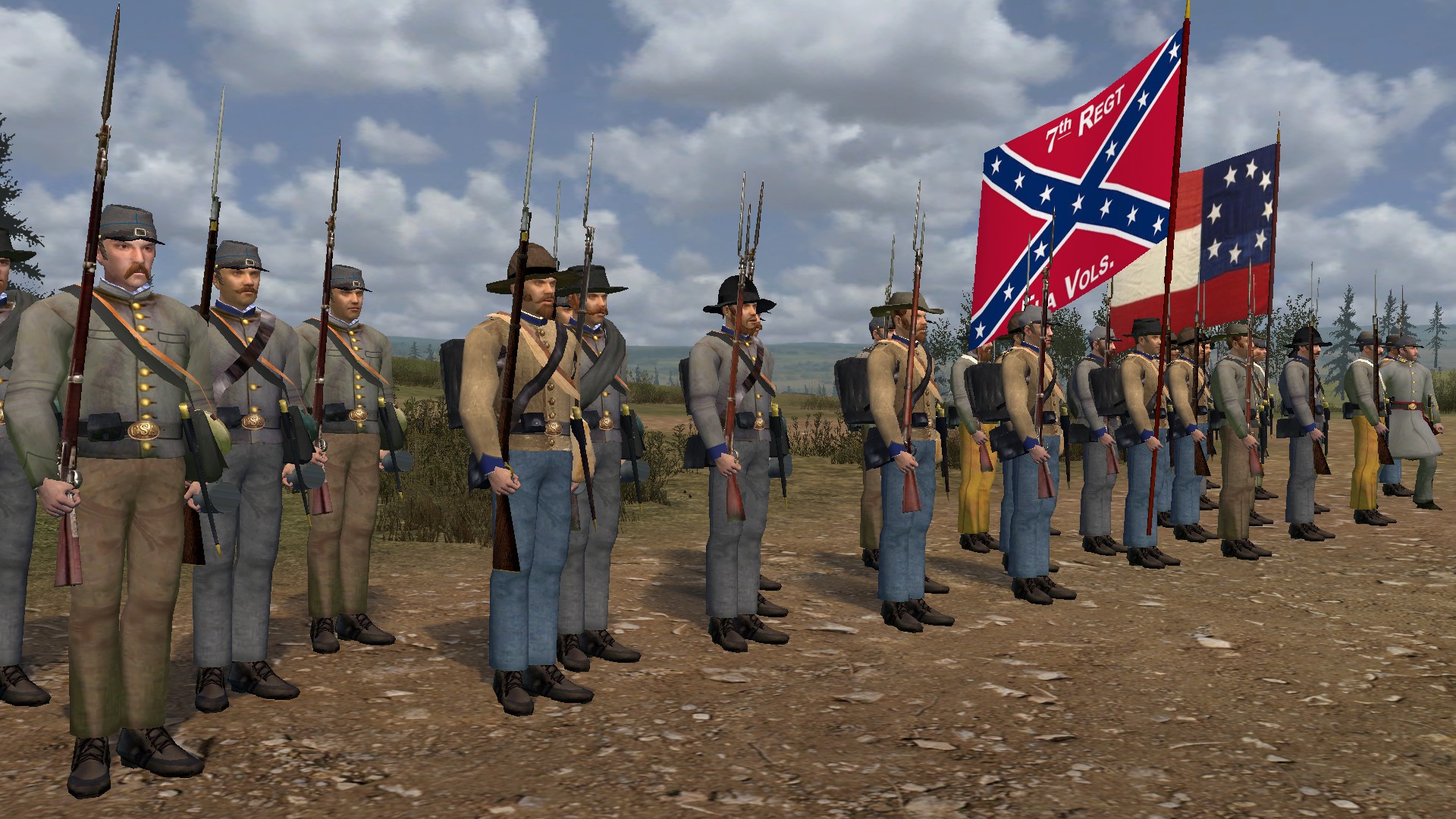
Weapons: Pattern 1853 Enfield Rifle Musket, Springfield Model 1842 Smoothbore Musket, Springfield Model 1816 Flintlock Musket, Springfield Model 1822 Smoothbore Musket, Springfield Model 1835 Smoothbore Musket, Springfield Model 1855 Rifle Musket, Springfield Model 1861 Rifle Musket
Faction: Army of Pensacola
Current Commander: Lieutenant General Edmund Kirby Smith
Recruitment Locations: St. Augustine, Tallahassee, Fort Ward, Fort Marion, Brunswick, Tampa, St. Marks, Madison, Olustee, Gainesville, Jacksonville
The 7th Florida Infantry Regiment was organized at Gainesville in April, 1862, and its companies were recruited in the counties of Bradford, Hillsborough, Alachua, Manatee, and Marion. The composite rosters of this unit contains the names of 1,759 men. During the war, the 7th Florida Infantry served in R.C. Trigg's, Finley's, and J.A. Smith's Brigades of the Army of Tennessee, and took an active part in the arduous campaigns of the army, from Chickamauga and the Atlanta Campaign, to the battles of Nashville and Franklin, and then participating in the Carolina's Campaign before fighting its last battle at Bentonville. The 7th Florida surrendered on April 26th, 1865.
Georgia
5th Georgia Infantry "Clinch Rifles"
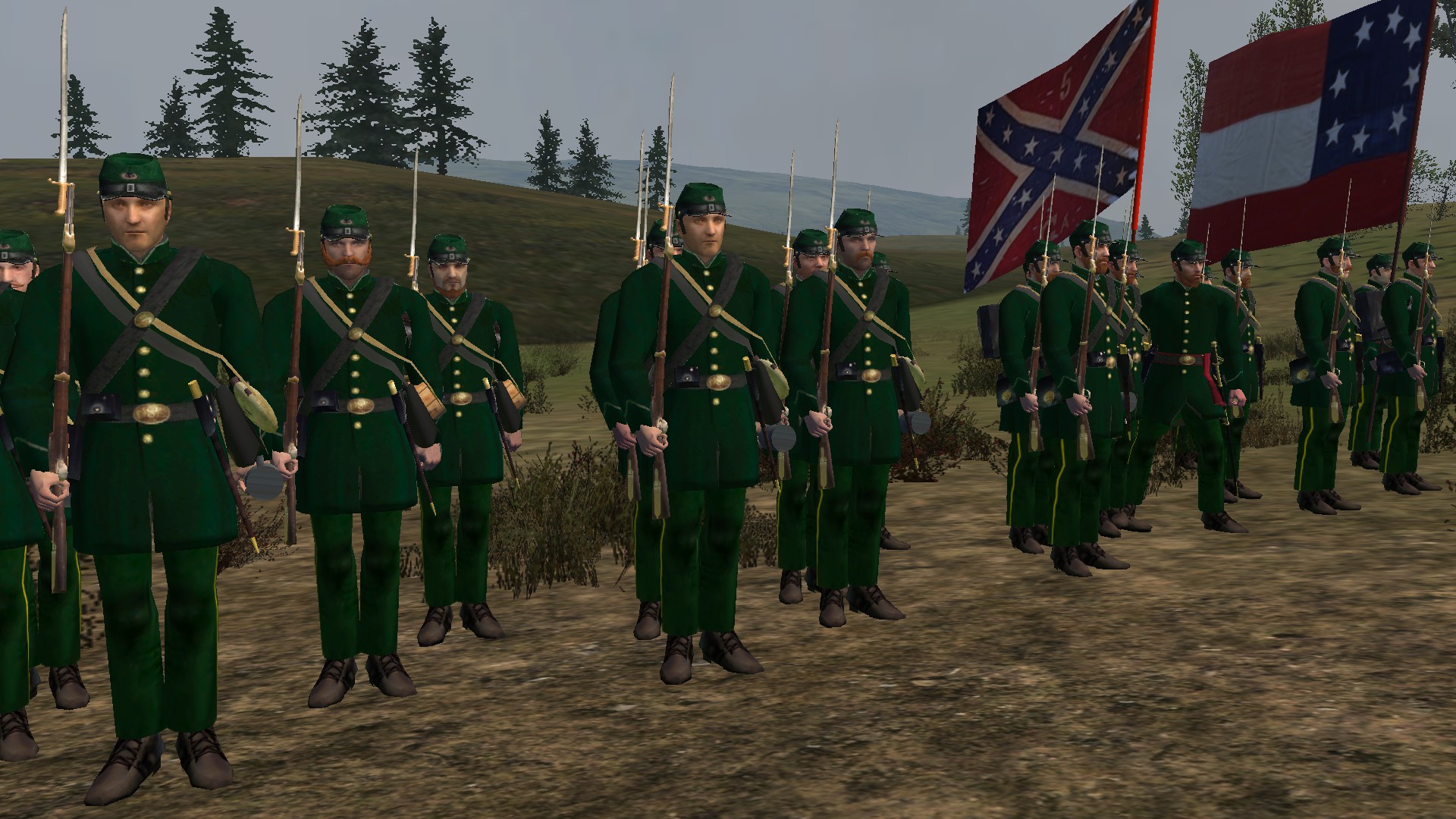
Weapons: M1841 Mississippi Rifle
Faction: Army of Tennessee
Current Commander: Major General William W. Loring
Recruitment Locations: St. Augustine, Tallahassee, Atlanta, Savannah, Fort Wagner, Calhoun, Augusta, Fort Ward, Fort Marion, Macon, Brunswick, Tampa, St. Marks, Madison, Olustee, Gainesville, Jacksonville, Murphy, Athens, Cedar Shoals
The 5th Georgia Volunteer Infantry was organized on May 11th, 1861, formed from 10 companies and first posted in Florida under General Bragg, where they received their training. One of the most famous and most well recognized names of the 5th Georgia, the Clinch Rifles, was named for General Duncan L. Clinch who served in the Seminole Indian War. The company, which was formed before the beginning of the Civil War in 1852, fought in almost every engagement of the regiment and was dissolved by the end of the war in 1865. The Clinch Rifles wore a simple, elegant uniform of a dark green single-breasted frock coat and matching trousers. Green kepis were worn, the cap badge on the front of the kepi being a laurel wreath with the initials 'CR' inside. The collar and French cuff flaps were outlined in the regimental color for the enlisted men and gold for the officers. The Clinch Rifles Uniform is the more widely known kind of uniform in the regiment, as one of the only to wear green into battle in the entire Civil War. Later in the war, the uniforms issued by the regiment were switched to the regular grey uniform as stricter regulation came into the army.
The 5th Georgia's first combat assignment was on Santa Rosa Island off the coast of Florida. The assault on the Island resulted in a victory and early experience for the regiment. Following this, the regiment was posted in early 1862 to Knoxville, Tennessee, and Corinth, Mississippi. They were ordered to move on Shiloh in April but arrived too late to participate in the battle. The regiment fought in and around Corinth until the end of May, when they were ordered to participate in the Invasion of Kentucky. Following the failure of the invasion, the regiment was engaged at the Battle of Stones River. This proved devastating to the 5th Georgia, where they received 32% casualties, including their Colonel, and the regimental battle flag was lost. Following this defeat the regiment pulled back to Shelbyville, Tennessee, where it remained until they went on to participate in the Tullahoma Campaign.
In September 1863, the regiment was back in their native state of Georgia. The 5th was hotly engaged at the Battle of Chickamauga, and endured heavy casualties; 55% of the regiment was lost. They participated in the Siege of Chattanooga on Missionary Ridge until they were driven from their position and fell back with the rest of the Army of Tennessee. The regiment suffered through a series of battles in their retreat through Georgia in early 1864 and served as prison guards until being moved to the South Carolina coast late that year. They fought to protect the Charleston and Savannah railroad, losing their battle flag a second time as they were forced to retreat. The 5th continued in retreat with the rest of the Confederate Army through North Carolina. They participated in the Battle of Bentonville in March, launching an assault against the Union XX Corp, where they encountered devastating fire and were forced to fall back. The Army of Tennessee surrendered on April 26th, 1865, where a few members of the regiment were present to witness the surrender at the Bennett Homestead.
29th Georgia Infantry "Thomasville Zouaves"
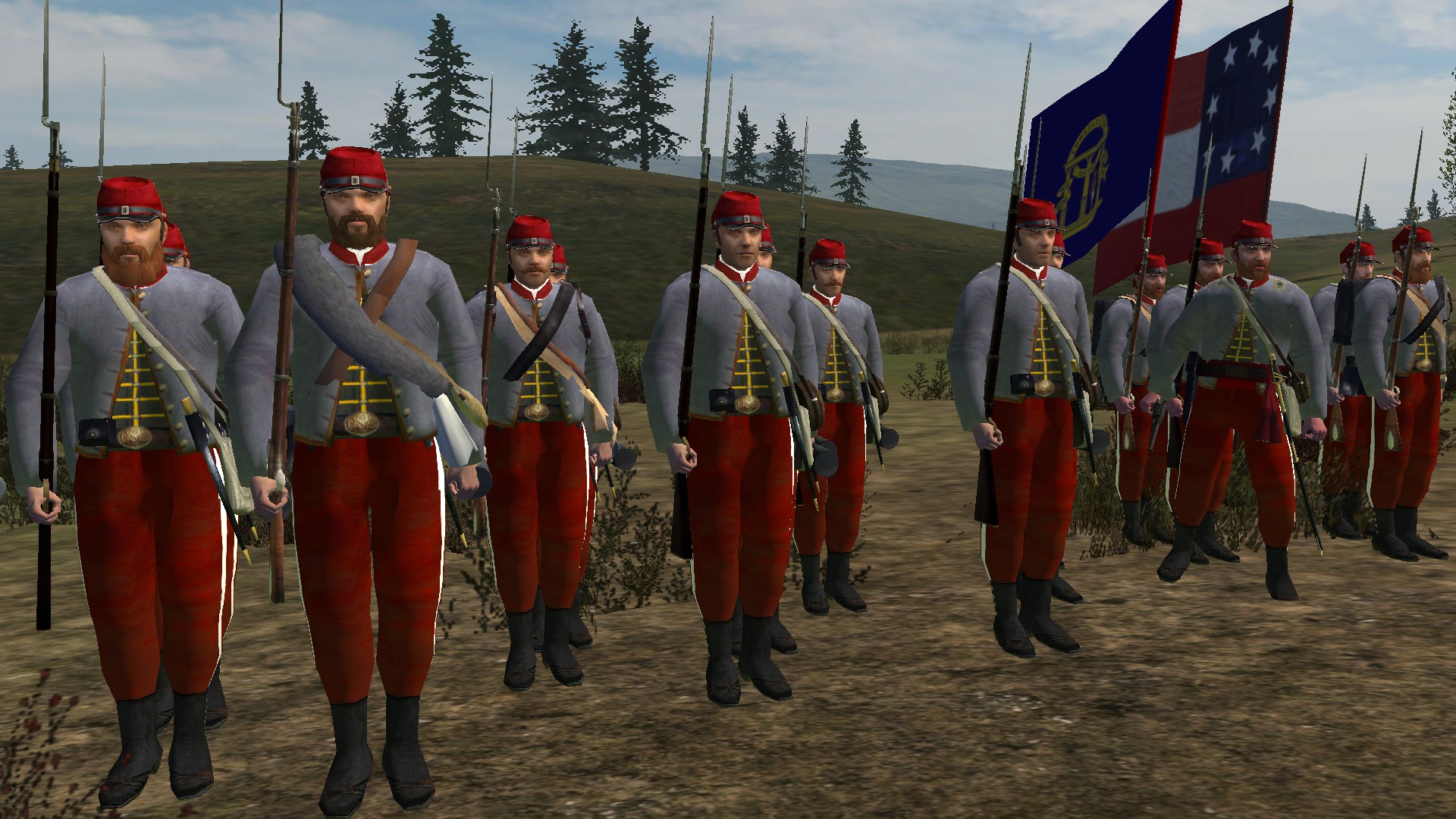
Weapons: Pattern 1853 Enfield Rifle Musket
Faction: Army of Pensacola
Current Commander: Brigadier General Nathan George Evans
Recruitment Locations: Atlanta, Savannah, Fort Wagner, Calhoun, Augusta, Macon, Murphy, Athens, Cedar Shoals
The 29th Georgia Infantry Regiment, organized at Big Shanty, Georgia during the summer of 1861, contained men from Thomas, Berrien, Tift, Stephens, and Dougherty counties. For a time, companies A and G served as heavy artillerists in the Savannah area and the rest of the command was at Charleston. It then was assigned to General Wilson's, C.H. Stevens', and H.R. Jackson's Brigade, and in September, 1863, was consolidated with the 30th Regiment. The unit participated in the difficult campaigns of the Army of Tennessee from Chickamauga to Atlanta, endured Hood's winter operations in Tennessee, and fought at Bentonville. In December, 1863, the 29th/30th totaled 341 men and 195 arms, but few surrendered on April 26th, 1865.
Kentucky
1st Kentucky Infantry "Orphan Brigade"
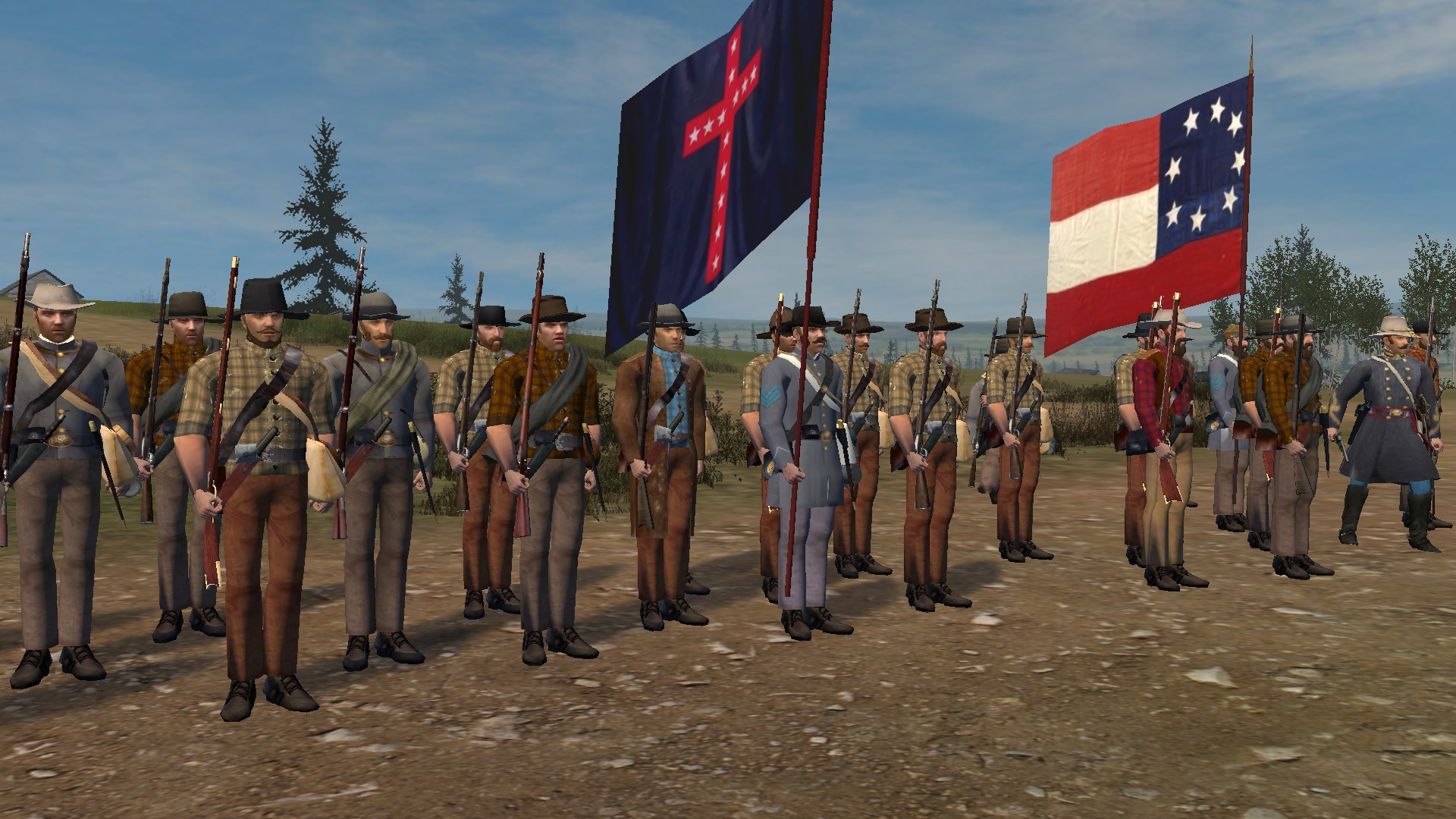
Weapons: Springfield Model 1842 Smoothbore Musket, Springfield Model 1816 Flintlock Musket, Springfield Model 1822 Smoothbore Musket, Springfield Model 1835 Smoothbore Musket, Hawken Rifle, Kentucky Rifle, Double Barrel Shotgun
Upgrades to: Pattern 1853 Enfield Rifle Musket
Faction: Army of Tennessee
Current Commander: Major General John C. Breckinridge
Recruitment Locations: Nashville, Fort Defiance, Chattanooga, Hopkinsville, Franklin, Clarksville, Murfreesboro, Johnsonville
After President Abraham Lincoln issued a call for 75,000 volunteer troops, the pro-Southern Governor of Kentucky, Beriah Magoffin's response was terse and to the point:
"I will send not a man nor a dollar for the wicked purpose of subduing my sister Southern states."
Despite their personal loyalties, Magoffin and other prominent Kentuckians sought to avert secession, maintain Kentucky's neutrality, and possibly play a role as a mediator in the conflict. Although Magoffin was forceful in his reply, the governor apparently did not speak for the majority of his own people, and perhaps more than any other state, Kentucky would come to know the dreadful meaning of the phrase, "brother against brother."
Kentucky's declared neutrality prevented Confederate recruiting officers from mustering units within its borders, however this didn't stop thousands of Kentuckians from crossing into Tennessee to enlist at Camps Boone and Burnett, near Clarksville. These early regiments, combined with others raised that fall at Bowling Green, were organized into the 1st Kentucky Brigade. The brigade was the largest Confederate unit to be recruited from Kentucky during the war. When the Orphan Brigade was mustered into service, weapons were in short supply, and the troops were armed with old smoothbore muskets (some flintlock and others percussion) along with shotguns and hunting rifles. The men were given a bounty if they brought their own rifle, however some men had no arms at all.
Going into 1862, the men of the Kentucky Brigade began to present a more uniform appearance, and only a week before the Battle of Shiloh, every regiment except the 9th Kentucky was issued a supply of Enfield rifles imported from England (the 9th armed themselves with Enfields captured during the battle).
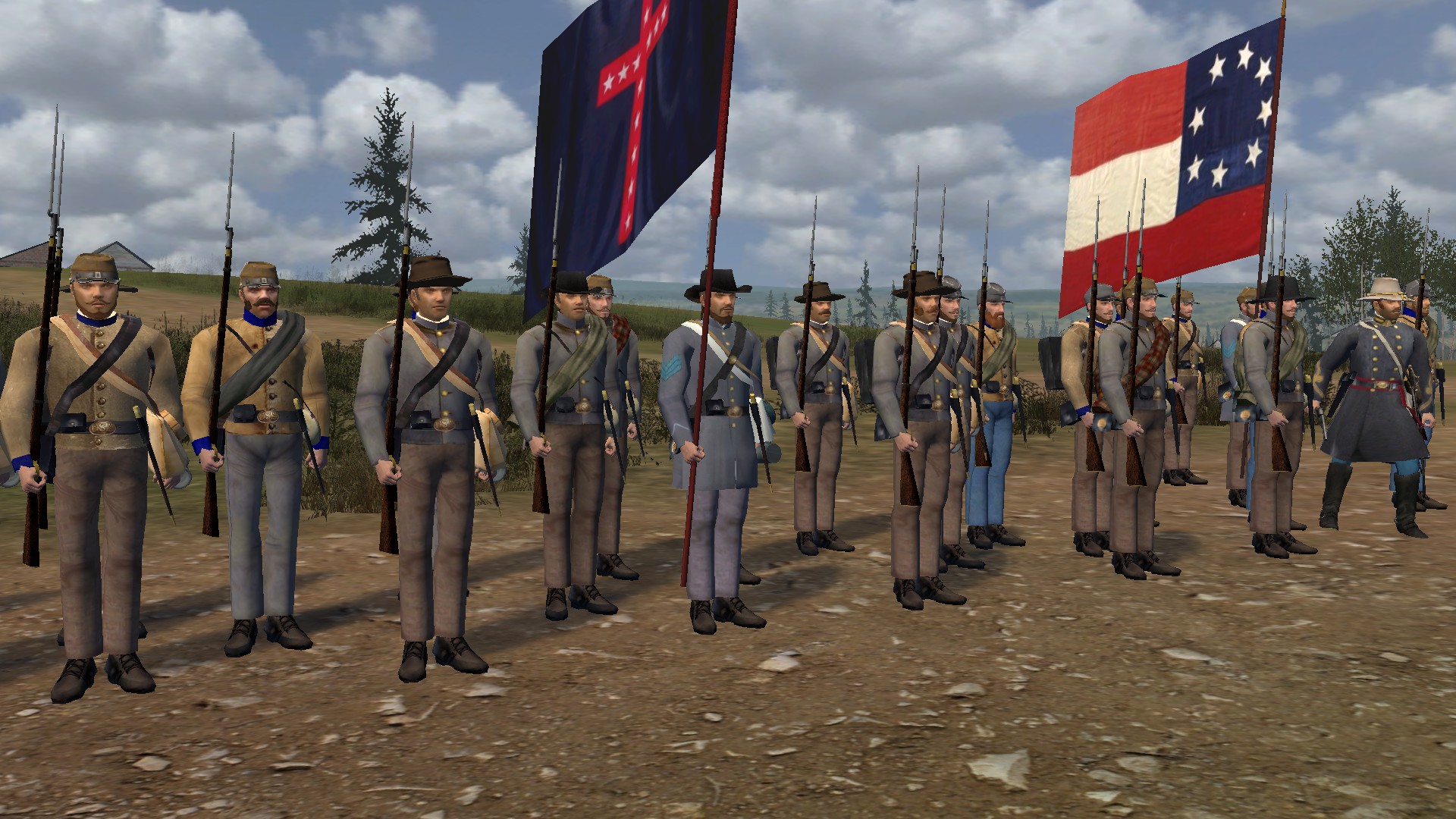
The brigade fought bravely and with distinction at a variety of battles throughout the Western Theater, including Shiloh and Stones River. At the Battle of Stones River, the brigade suffered heavy casualties in an assault on January 2nd, 1863, including General Roger W. Hanson, who had replaced Major General John C. Breckinridge as the brigade's commander. According to legend, Breckinridge, who vehemently disputed the order to charge with the army's commander, General Braxton Bragg, rode among the brigade's survivors, crying out repeatedly, "My poor Orphans! My poor Orphans!"
The origins of their nickname, "Orphan Brigade", are uncertain, and there is little evidence that use of the term was widespread during the conflict, but the veterans certainly felt the sentiment was appropriate and embraced it. Besides Breckinridge's legendary quote, one possible provenance of the name stems from Kentucky's tenuous political situation. Men had to leave the state to enlist in the Confederate army, and were unable to return home for fear of being indicted by the Union government, therefore becoming "orphaned" from their home state.
The Orphan Brigade lost another commander at the Battle of Chickamauga, when Brigadier General Benjamin H. Helm, Abraham Lincoln's brother-in-law, was mortally wounded on September 20th, 1863, and died the following day. The Orphan Brigade served throughout the Atlanta Campaign of 1864, then were converted to mounted infantry and opposed Sherman's March to the Sea.

They ended the war fighting in South Carolina in late April 1865, and surrendered at Washington, Georgia, on May 6th – 7th, 1865, receiving generous parole terms. Those in mounted units kept their horses or mules, and every seventh man was allowed to retain his musket for the journey home.
Louisiana
7th Louisiana Infantry "Pelican Regiment"
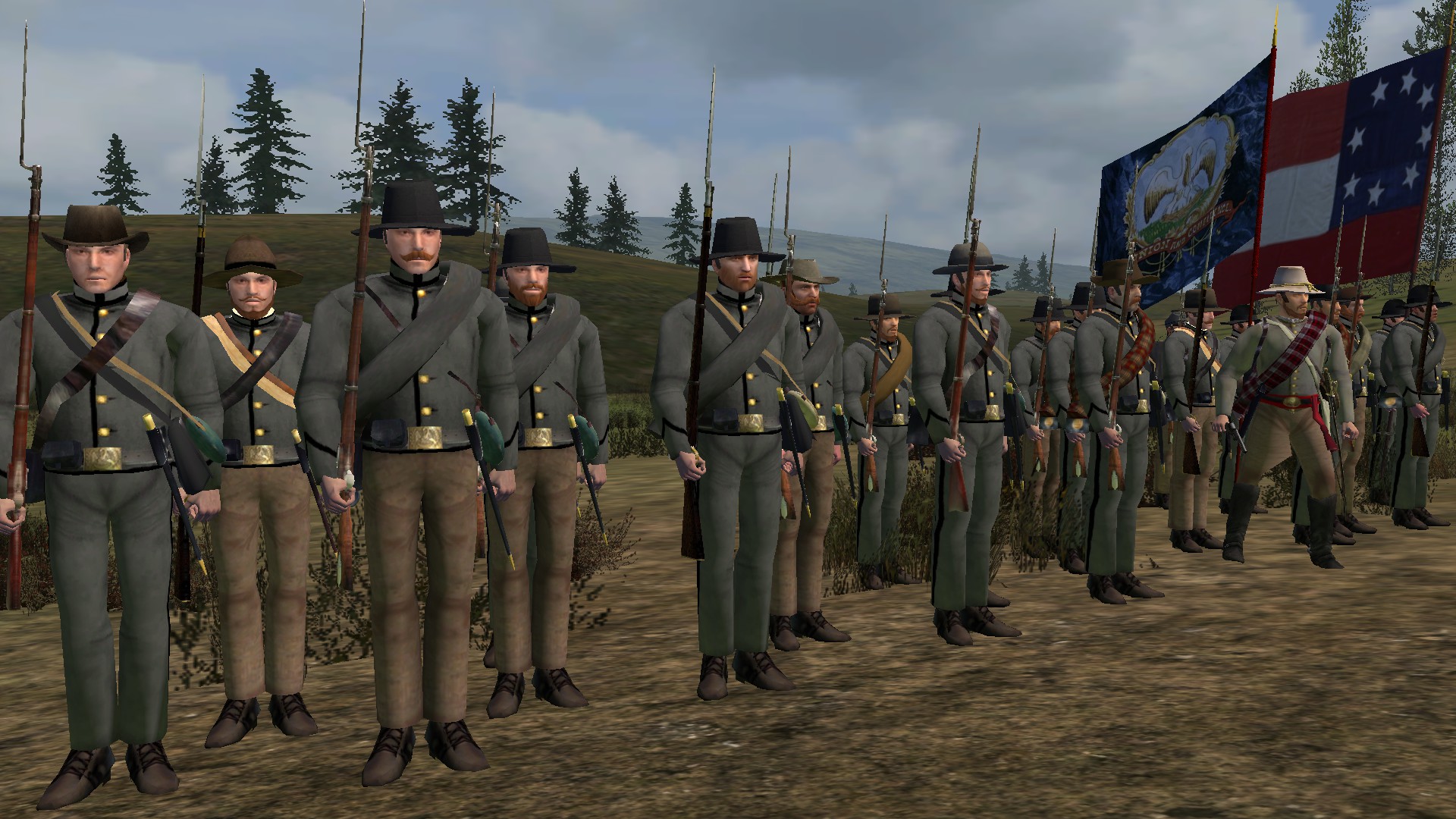
Weapons: Pattern 1853 Enfield Rifle Musket, Springfield Model 1861 Rifle Musket, Springfield Model 1855 Rifle Musket, M1841 Mississippi Rifle, Lorenz Rifle Model 1854
Faction: Army of Northern Virginia
Current Commander: Lieutenant General Richard S. Ewell
Recruitment Locations: New Orleans, Petersburg, Chancellorsville, Meridian, Alexandria LA, Port Hudson, Baton Rouge, Gordonsville, Winchester, Hammond
The 7th Louisiana Infantry, nicknamed the "Pelican Regiment", was formed at Camp Moore in Baton Rouge, Louisiana on June 5th, 1861, with 944 soldiers organized into ten companies under the command of Colonel Harry T. Hays, a Louisiana lawyer and politician who later became general of the 1st Louisiana Brigade. The regiment was made up of men from New Orleans and the surrounding area, many of whom were members of the city's affluent and influential Creole community. Soon after being organized, the 7th Louisiana Infantry was ordered to travel to Virginia, where it saw action in numerous significant battles throughout the Civil War, including but not limited to the first and second battles of Bull Run, Antietam, Fredericksburg, Chancellorsville, Gettysburg, the Wilderness, Cold Harbor, Spotsylvania Court House, Petersburg, and Appomattox.
At Antietam, the regiment suffered some of it's heaviest losses, with 62% of it's men killed, wounded, or missing. Despite these losses, the regiment continued to serve with the Army of Northern Virginia with notably high morale and a tenacious fighting spirit. On the evening of July 2nd, 1863, the regiment was part of the Confederate forces ordered to assault the east side of Cemetery Hill at Gettysburg, and after hand-to-hand fighting, they broke through the Union defenses in several places and got among the cannons. However, a lack of support and Union reinforcements forced the Confederates to retreat. In the Battle of the Wilderness, when Brigadier General Leroy A. Stafford's 2nd Louisiana brigade was routed and Stafford mortally wounded, Hays' brigade filled the gap in the defensive line. Pressing forward in dense woods, Hays' brigade attacked two Union brigades and was mauled. A Virginia regiment that attached itself to Hays' right flank was practically wiped out. Hays' aide estimated that the 1st Louisiana Brigade lost one-third of its strength in this battle.
By the time of the Battle of Cedar Creek, the 5th, 6th, and 7th Louisiana Infantry were so reduced in strength that they were consolidated into a single unit. During the winter of 1864-1865, they served in the trenches at Petersburg, and when Robert E. Lee surrendered at Appomattox in April 1865, only 42 men remained with the 7th Louisiana Infantry.
10th Louisiana Infantry "Lee's Foreign Legion"
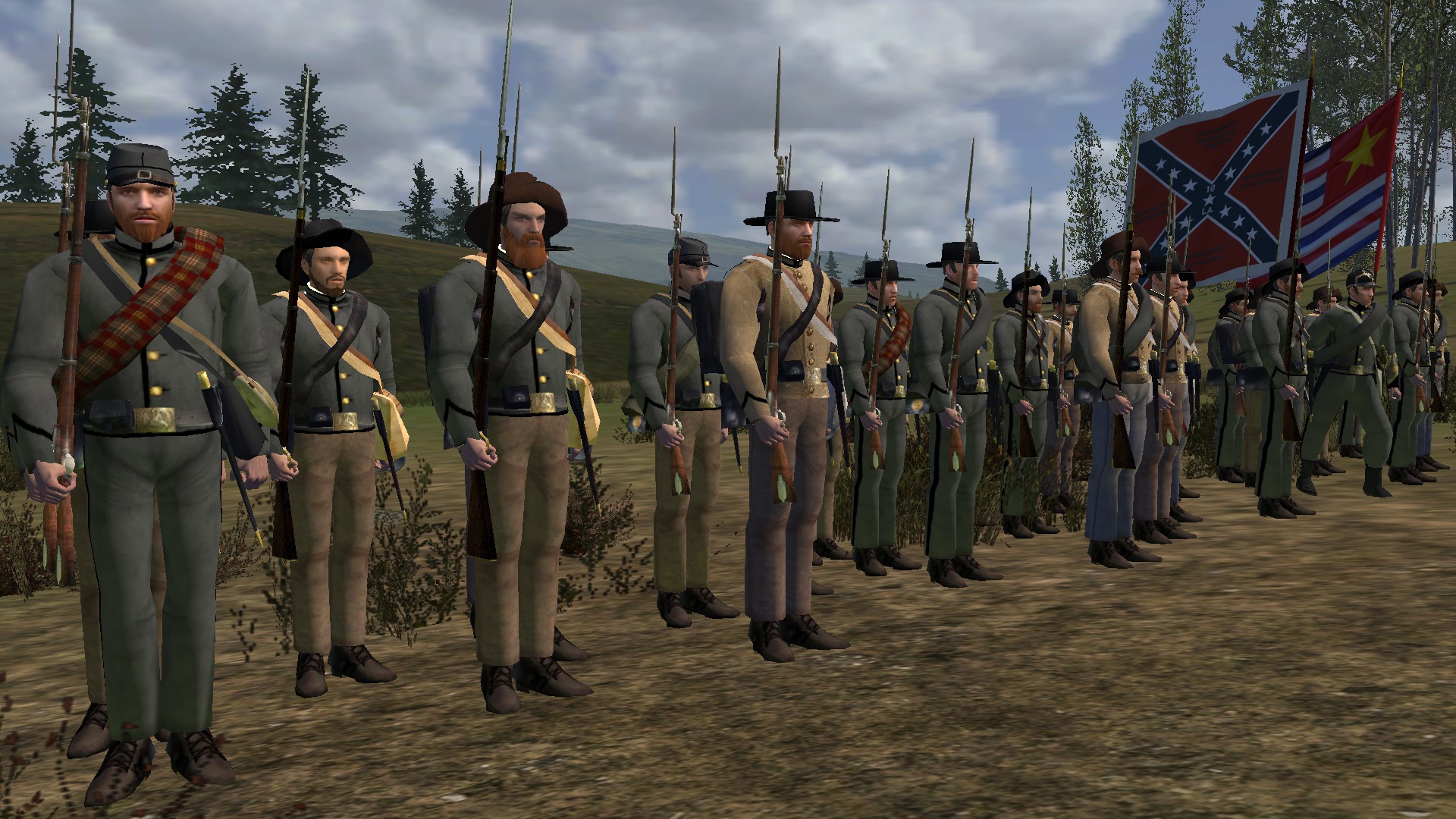
Weapons: Pattern 1853 Enfield Rifle Musket, M1841 Mississippi Rifle, Springfield Model 1855 Rifle Musket, Springfield Model 1861 Rifle Musket, Lorenz Rifle Model 1854
Faction: Army of Northern Virginia
Current Commander: Major General John B. Magruder
Recruitment Locations: Richmond, Fredericksburg, New Orleans, Shepherdstown, Petersburg, Alexandria LA, Lynchburg, Williamsburg, Port Hudson, Baton Rouge, Mechanicsville, Hammond
The 10th Louisiana was known as "Lee's Foreign Legion" because it was so ethnically diverse, consisting of men from 21 different nationalities. Louisiana units - especially those recruited in New Orleans - tended to be very cosmopolitan, but the 10th was perhaps one of the most.
According to Lee's Tigers Revisited by Terry L. Jones, p. 404,
"The regiment was composed of men from 21 nations (only three of the companies were predominantly Anglo-American), and most were laborers, farmers, and sailors. Of those giving a place of birth, 170 were born in Louisiana; 71 in states outside Louisiana; 249 in Ireland; 84 in the Germanic states; 44 in France; 26 in Italy; 24 in England; 20 in Spain; 9 in Canada; 7 each in Austria, Greece, and Mexico; 5 in Gibraltar; 4 in Portugal; 3 in Sicily; 2 in Norway; and 1 each in Corsica, Cuba, Martinique, Russia, Sardinia, and Switzerland."
The 10th Louisiana fought in many engagements with the Army of Northern Virginia, from the Battle of Williamsburg to the Battle of Cold Harbor. At the Battle of Gettysburg in July 1863, the regiment was part of the brigade of Colonel Jesse Williams and participated in a series of unsuccessful attacks on the Union entrenchments at Culp's Hill. There the regiment lost more than 45% of the 226 men engaged. On April 9th, 1865, only 4 officers and 13 men were left to surrender after the Battle of Appomattox Court House.
Wheat's Louisiana Tiger Rifles Infantry
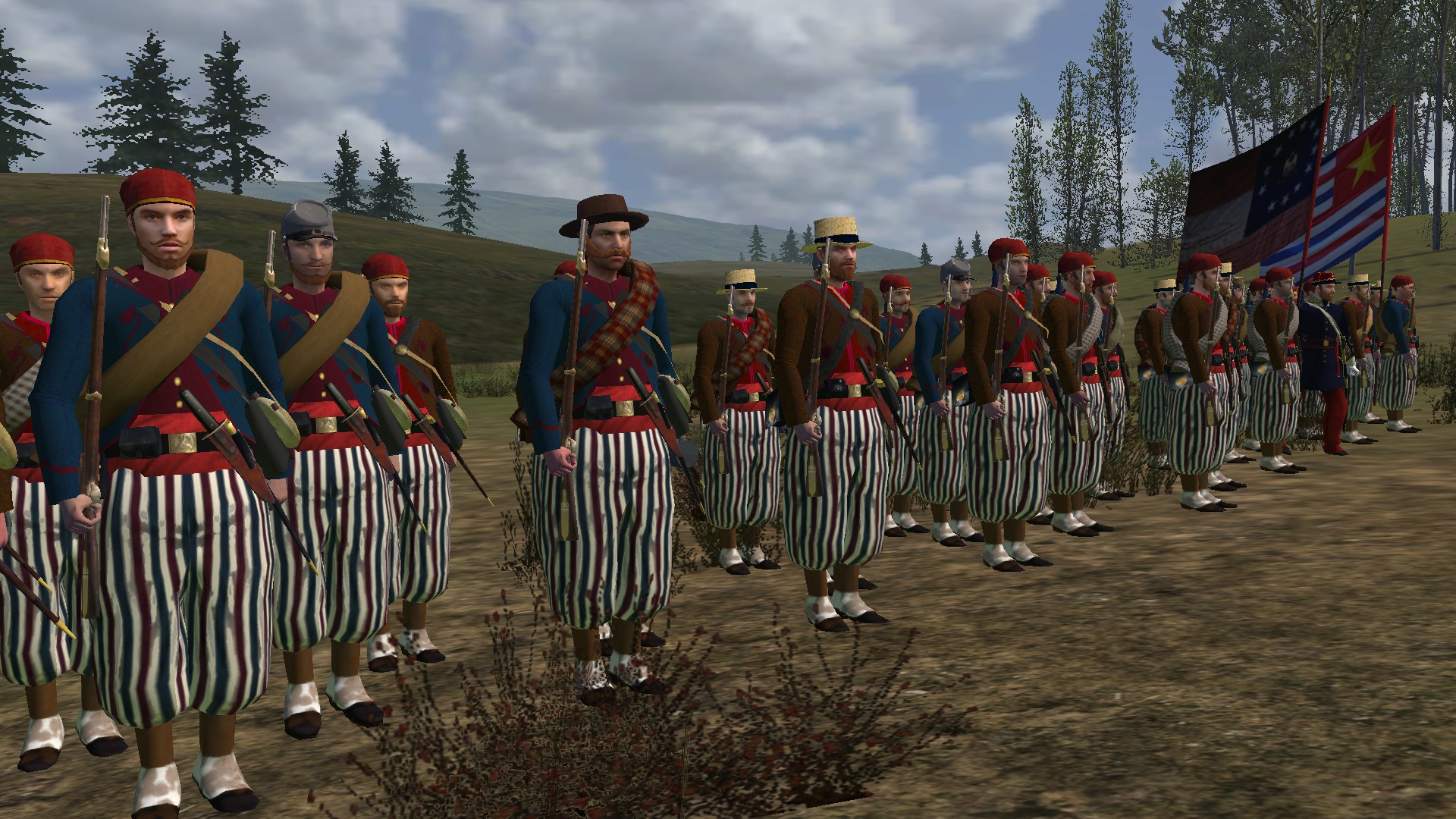
Weapons: M1841 Mississippi Rifle
Faction: Army of Northern Virginia
Current Commander: Lieutenant General Richard H. Anderson
Recruitment Locations: New Orleans, Meridian, Alexandria LA, Mobile, Port Hudson, Baton Rouge, Hammond
"Louisiana Tigers" was the common nickname for certain infantry troops from the State of Louisiana in the Confederate Army. The origin of the term came from the "Tiger Rifles," a volunteer company raised in the New Orleans area as part of Major Chatham Roberdeau Wheat's 1st Special Battalion, Louisiana Volunteer Infantry (2nd Louisiana Battalion). The nickname eventually expanded to apply from the original company to a battalion, then to a brigade, and eventually to all Louisiana troops within the Army of Northern Virginia. Although the exact composition of the Louisiana Tigers changed as the war progressed, they developed a reputation as fearless, hard-fighting shock troops.
Mississippi
3rd Mississippi Infantry "Sunflower Dispersers"
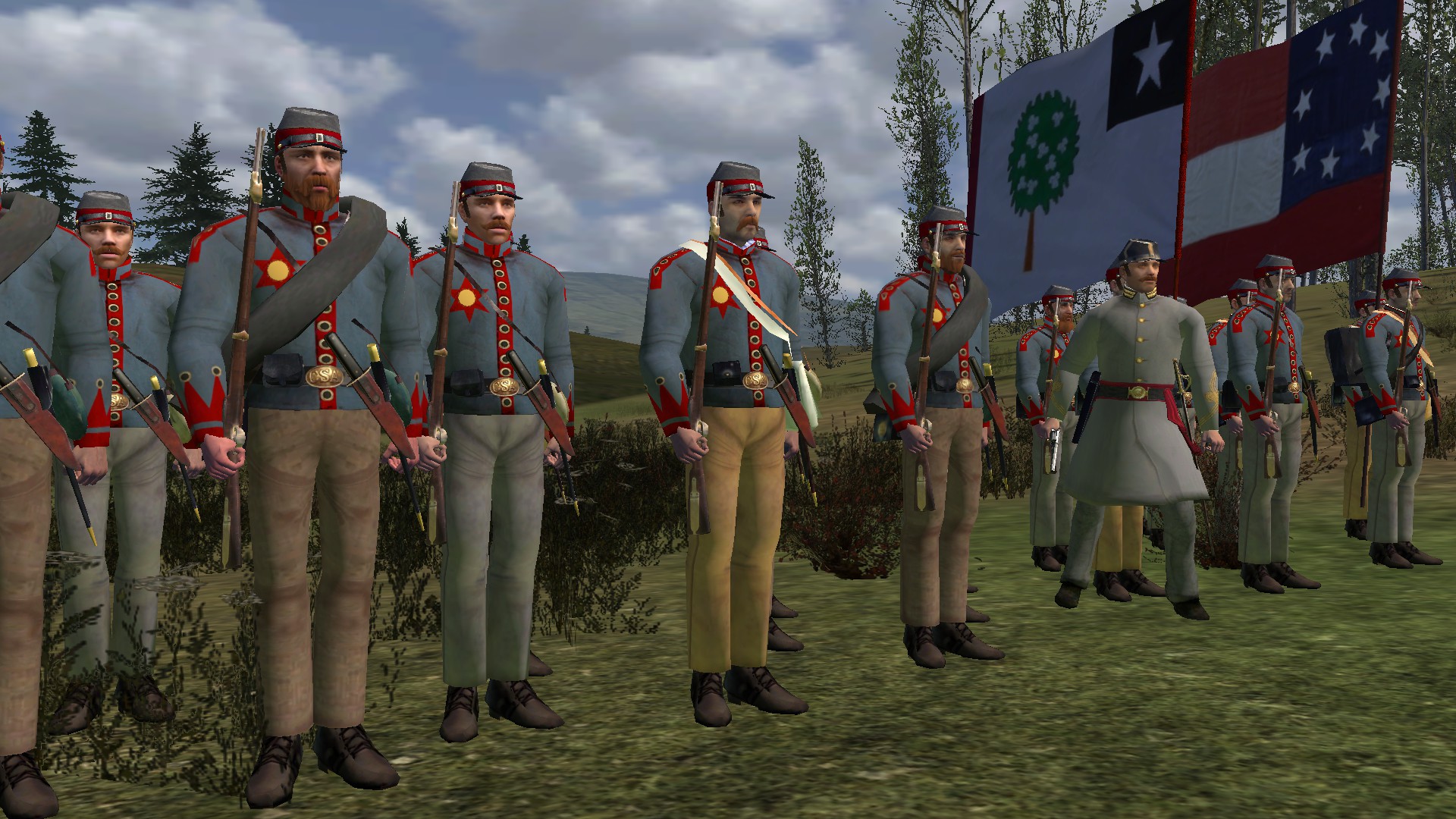
Weapons: M1841 Mississippi Rifle
Faction: Army of Tennessee
Current Commander: Lieutenant General William J. Hardee
Recruitment Locations: Jackson, New Orleans, Vicksburg, Corinth, Memphis, Little Rock, Fort Donelson, Shreveport, Fort Henry, Meridian, Greenville, Blair's Landing, Paducah, Port Hudson, Baton Rouge, Port Hudson, Shiloh, Tupelo
Company B of the 3rd Mississippi Infantry named themselves the "Sunflower Dispersers" after having been raised in Sunflower County. They were organized on the 9th of September, 1861, and the company was mustered into service at Camp Clark, Bay St. Louis, by First Lieutenant Charleston Hurst. Confederate regiments consisted of companies that were raised in different counties within their namesake states, and each company was allowed to uniform and equip themselves however they wanted (or as available supplies allowed). The result was a wide variety of all conceivable forms of uniform dress, colors and style that would be represented even in one regiment during the early months of the Civil War. In the case of the Sunflower Dispersers, photographic evidence shows members of this company dressed in grey battle shirts trimmed in the state regulation color of red with a sunflower symbol on the right breast of the shirt. The 3rd Mississippi was also issued the M1841 Mississippi Rifle.
The 3rd Mississippi Infantry was commanded by Colonel John B. Deason and served in the Western Theater, initially assigned to the Army of Mississippi. The Sunflower Dispersers fought at Shiloh and Fort Pemberton, and participated in the sinking of the Cairo on the Yazoo River by the first successful launching of a floating land mine. The regiment went on to participate in many of the major combat actions of the Western Theater where some of the most ferocious fighting took place, including the defense of Vicksburg, the Atlanta Campaign and the disastrous battles of Franklin and Nashville.
In the battle near Kennesaw Mountain on June 27th, brought on by a Union attack, the 3rd Mississippi Regiment on the skirmish line under Major Dyer, along with Stigler's Sharpshooters, were in front of the brigade, and sustained the attack and held the Union line in check through the day. Repulsing one advance that came within sixty yards of their position, at 4:00 P.M. Featherston reported, "A brisk fire was kept up on this line during the evening, and both the battalion and 3rd Mississippi Regiment acted with great coolness, courage and determination." In general orders, Private J. W. Patterson of Company C was commended for gallantry on picket duty at Kennesaw Mountain. In the battle of Peachtree Creek on July 20th, Colonel Mellon commended the regiment, which joined in the charge of the brigade across the creek and gained a position on the summit of a slight elevation, partially protected by a rail fence. Colonel Mellon was severely wounded as this position was gained, and Captain A. F. Ramsey and Lieutenant John P. Gressett were killed as well. Lieutenant Colonel Dyer took command, and after losing many of his best men, and being exposed on both flanks, he withdrew from the attack with the brigade. The casualties were 11 killed, 71 wounded, 6 missing. They were again in battle on July 28th, and after that served in the trenches around Atlanta until the evacuation, on September 1st.
On November 20th, Stewart’s Corps, formerly known as the Army of the Mississippi, crossed the Tennessee River. After marching to Columbia to confront Schofield's Corps, and toward Spring Hill on the 29th in the attempt to cut off the Union retreat, Loring's Division joined in the assault upon the entrenched lines at Franklin on November 30th. Loring's Division, on the right of Stewart's line, toward the Harpeth River, had to cross a deep railroad cut, an abatis and a hedge of Osage orange, all the while exposed to a destructive artillery fire and without much artillery support of their own. The battle raged from four in the evening until late at night, the Confederate line pressing forward again and again with dauntless courage and meeting with terrible loss.
General Featherston reported that three flags were lost by his brigade, "The color bearers of the 3rd and 22nd planted their colors on the enemy's works and were wounded and captured with their colors." The flag of Company I was adopted as that of the regiment; James A. Sconyers of this company was the color bearer and the flag of Company I continued to be that of the regiment until the Stars and Bars was chosen by the Confederacy. The flag of Company I was borne in every engagement until the battle of Franklin, when Lieutenant John Cherry of the Downing Rifles planted it on the breastworks, and in so doing fell with the flag, wounded, inside the works. Lieutenant Colonel S. M. Dyer, commanding the 3rd Mississippi, was among the wounded. Among the killed were Adjutant L.M. Long, Lieutenant J. T. Young and Lieutenant A. J. Russell. The casualties of the regiment were 13 killed, 40 wounded, 20 missing.
They were then before Nashville, Loring's Division occupying an entrenched line one mile long, across the Granny White pike, to support the redoubts which were partly completed on five hills. When Union General George H. Thomas attacked on December 15th, General Edward C. Walthall manned the redoubts with his division, and French's and Johnson's Divisions reinforced them. But two of the redoubts were overcome by Union forces, and they pushed down the road, compelling Walthall to abandon the line, and not a moment too soon. This made it necessary for Loring to withdraw as well and he was directed to form along the Granny White Pike, nearly at right angles to his former position, to check the anticipated rush of the Union soldiers from his and Walthall's fronts. This was successfully done by the division, and the corps retired to a position between the Granny White and Franklin pikes, when night put an end to the fighting. The next day, Stewart's Corps repulsed every attack made upon them, but finally Bate’s line, on their left, was broken, and the entire army retreated in confusion to Brentwood.
The Army of the Mississippi covered the retreat across Duck River from December 18th to the 20th. At Columbia, on December 20th, a rear guard of infantry was organized under the command of General Walthall, including Featherston's Mississippians and six other brigades. The 3rd Mississippi counted a total of 75 men present, with 51 still fit for duty. They remained at Columbia confronted by a heavy force of the enemy, until the army had been on the march for 48 hours. On the march they traversed roads covered with snow and ice, numbers of the men without shoes, some without blankets and all poorly clad for the winter season. At Anthony's Hill on December 25th, and at Sugar Creek the next day, Featherston's Brigade was distinguished in checking the Union pursuit, making considerable captures of men and horses. The men of the Army of the Mississippi were again the last to cross at the Tennessee River, from December 26th to the 28th.
About the 1st of February, 1865, the remnant of Loring's Division began the movement to reinforce General Johnston in the Carolinas, Sherman having marched to Savannah. Survivors of the 3rd Mississippi, with their ranks shredded from losses, were ordered forward from Augusta, Georgia, to Newberry, South Carolina, on February 25th. In the Carolina Campaign, they participated in the battles of Kinston on March 10th, and Bentonville on March 19th, on the latter day making a courageous charge and suffering heavy losses. With it's ranks shattered, containing only a handful of it's original members, the 3rd Mississippi was consolidated with the 33rd and the 40th Mississippi Infantry Regiments and continued to fight on until the surrender of Johnston's army to General Sherman on April 26th, 1865.
11th Mississippi Infantry "University Greys"
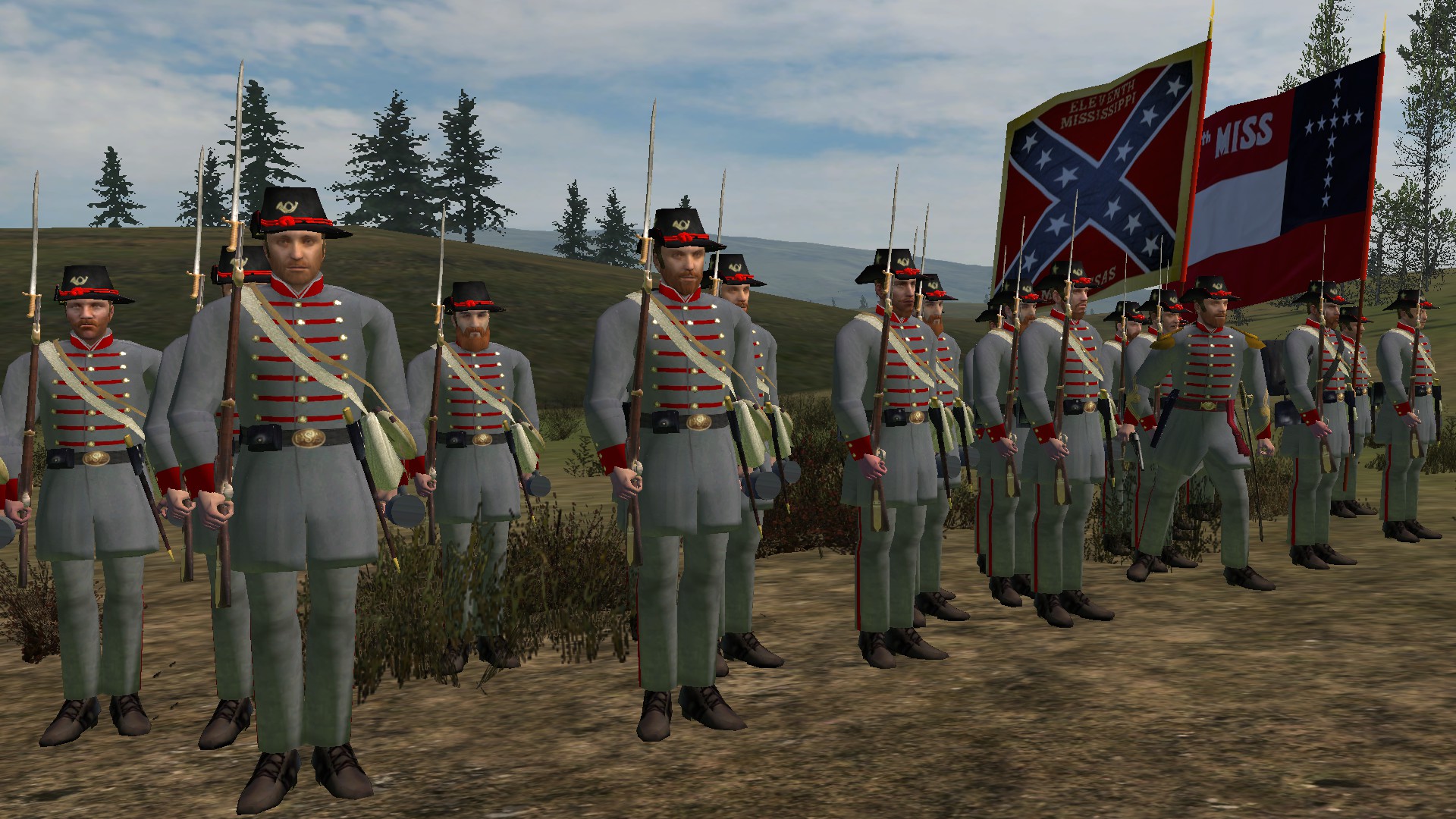
Weapons: M1841 Mississippi Rifle
Faction: Army of Northern Virginia
Current Commander: Major General Henry Heth
Recruitment Locations: Jackson, Vicksburg, Corinth, Memphis, Little Rock, Meridian, Greenville, Paducah, Pea Ridge, Shiloh, Tupelo, Hammond
The University Greys (or Grays) were Company A of the 11th Mississippi Infantry Regiment, part of the Army of Northern Virginia. The Greys served in many of the most famous and bloody battles of the war. The rifle company joined the 11th Infantry at its inception on May 4th, 1861 after Mississippi seceded from the Union. Their name "University Greys" derived from the gray color of the men's uniforms and from the fact that almost all of the Greys were students at the University of Mississippi. 135 men enlisted with the regiment, which was nearly the entire student body; only four students reported for classes in the autumn of 1861, so few that the university closed temporarily.
On July 18th, 1861, the 11th Mississippi were ordered to support General Beauregard at Manassas. The sick were left at Winchester and the regiment marched through Ashby’s Gap to Piedmont. Companies A and F under Lieutenant Colonel Liddell boarded a train for Manassas with the 2nd Mississippi. Companies A and F arrived at Manassas at about noon on July 20th. They accompanied the 2nd Mississippi and were put in a supporting position behind McLean's and Blackburn's Fords on Bull Run. The rest of the regiment under Colonel Moore boarded the train that had been sent back from Manassas. It would not reach the battlefield in time for the battle. On July 21st, companies A and F under Lieutenant Colonel Liddell were sent along with General Bernard Bee's brigade to reinforce the endangered left flank. They arrived at the scene of the fighting around 11:00 a.m., crossing Young's Branch and forming a defensive line that was supported by two batteries. Under heavy small arms and artillery fire that mortally wounded General Bee, the companies fell back with heavy losses and reformed behind Jackson's Brigade. They then joined Jackson in the attack on the Union batteries. The two companies lost 7 men killed and 21 wounded in this engagement.
The regiment was present at the Battle of Seven Pines from May 31st to June 1st, 1862, where they supported the 3rd Alabama in its attack on the 52nd New York. They then moved to the front line, taking heavy casualties, including Captain William B. Lowry, who was wounded in the face. In mid-June, the regiment was sent with Whiting’s Division to temporarily reinforce Jackson’s Army of the Valley. On June 27th, the 11th Mississippi, with the rest of Law’s Brigade and Hood’s Brigade, charged and broke the center of the Union line at the Battle of Gaines' Mill. Of the 400 men engaged, 18 were killed, 142 wounded, and 3 missing. Major Evans, Captain Reuben O. Reynolds, and Captain George Shannon were wounded in the fighting.
The 11th Mississippi was present for the Battle of Malvern Hill on July 1st, but did not take an active part in the fighting. However, 1 man was killed and 20 were wounded from artillery fire. In mid-July, the regiment with Whiting's Division was transferred to Longstreet's Command. General Whiting left on medical leave on the 26th, and Brigadier General John B. Hood took over command of the division. The regiment was engaged at the Battle of Second Manassas from August 29th to the 30th, losing 4 men killed and 55 wounded. The 11th marched from Hagerstown to Turner's Gap along the National Road, arriving at around 3 p.m. to participate in the Battle of South Mountain. The regiment launched a bayonet charge to turn back Union troops who were forcing their way through the pass. On the 15th, the regiment withdrew to a position behind Antietam Creek near Sharpsburg. Hood’s Division acted as the rearguard for the army. The next day, they were positioned by the Dunker Church, and threw back a Union advance at dusk along the Smoketown Road. Colonel Liddell was mortally wounded, and later died from this wound on September 25th. Lt. Colonel Samuel F. Butler took command of the regiment. September 17th marked the first day of the Battle of Antietam, and being attacked at dawn by Union General Joseph Hooker's First Corps, Hood’s Division counterattacked in the infamous corn field. General Hood wrote of this engagement:
“I soon became engaged with an immense force of the enemy, consisting of not less than two corps of their army. It was here that I witnessed the most terrible clash of arms, by far, that has occurred during the war. The two little giant brigades of this division wrestled with this mighty force, losing hundreds of their gallant officers and men, but driving the enemy from his position and forcing him to abandon his guns on our left.”
The 11th Mississippi lost 8 men killed and 96 wounded out of around 200 men. Lt. Colonel Butler was mortally wounded in the stomach, later dying from this wound on October 3rd, and Major Taliaferro Evans was killed when he took command from Butler. During this engagement, the 11th Mississippi's color bearer was killed and the regimental colors lost.
In the Spring of 1863, the regiment and its brigade joined General Longstreet for the Suffolk Campaign. The 11th, along with Longstreet’s command, returned to Lee's army on the Rappahannock in May, but arrived too late to take part in the Battle of Chancellorsville. On July 1st, the regiment was assigned to guard the baggage trains and missed the opening fighting of the Battle of Gettysburg. It rejoined Davis' Brigade on July 2nd, but the brigade was held in reserve due to its heavy casualties the day before. On the 3rd day of battle, the brigade took part in Pickett’s Charge. The 11th Mississippi was the regiment on the left flank of the brigade. Brockenbrough's Brigade took heavy fire from its front and flank by artillery fire and collapsed well short of the Union lines. They were also subjected to a surprise musket volley from the 8th Ohio Infantry regiment, which so surprised Brockenbrough's Virginians—already demoralized by their losses to artillery fire—that they panicked and fled back to Seminary Ridge, crashing through Trimble's division and causing many of his men to flee as well.
The 11th Mississippi's colors and a handful of men made it to the stone wall that was the Union defensive line and were killed or captured there. The Greys penetrated further into the Union lines than any other Confederate regiment, but at a terrible cost. Major Reynolds was wounded, and Company A, the University Greys, were completely wiped out, with every man from the company being killed or wounded in Pickett's Charge. In total, of the 393 men from the 11th Mississippi that were engaged, 110 were killed in action or died of wounds, 193 were wounded or captured while wounded, and 37 were taken as prisoners of war, uninjured. Those who survived Gettysburg were merged with the 11th Mississippi's Company G, the "Lamar Rifles", where they served out the remainder of the Civil War.
On July 14th, the regiment served with the rest of Heth's Division as rear guard for Lee's Army while crossing the Potomac at the Battle of Falling Waters. The 11th was temporarily under the command of General Pettigrew since Heth's wound at Gettysburg on July 1st. Here the regiment fought off an attack by Union cavalry, losing 9 men. In October, the 11th Mississippi was engaged at Bristoe Station, losing 4 men wounded. From November to December 1863, the regiment participated in the Mine Run Campaign, and then wintered in camp near Orange Court House.
On May 5th, 1864, the 11th Mississippi moved up the Orange Plank Road to meet Union forces moving through the wilderness. The regiment was on the left of Heth's Division, north of the Plank Road, and held off a series of attacks by Union General Hancock's Second Corps. The brigade was relieved at dusk by Thomas' Brigade of Wilcox's Division and moved south of the Plank Road. On May 6th, the Union pre-dawn attack broke the Confederate line but the 2nd, 11th, 29th and 42nd Mississippi regiments held the line for two hours until Longstreet's reinforcements reached the battlefield and launched a counterattack. The brigade reformed and attacked when Longstreet was wounded and his attack stalled. It pushed back Union troops threatening an Alabama brigade, then built and defended a log barricade until withdrawn to Lee's defensive line. On May 10th, Colonel Francis Green was mortally wounded at the Battle of Po River, later dying on the 15th, and Major Reuben O. Reynolds took command of the regiment. From May 12th to the 21st, the regiment was only lightly engaged as skirmishers at the Battle of Spotsylvania Courthouse. Casualties for the regiment for the first two weeks of May were 14 killed, 55 wounded and 6 missing.
From May 23rd to the 26th, the 11th Mississippi was engaged at the Battle of North Anna, and on June 3rd, the regiment participated in the Battle of Cold Harbor, losing 6 men killed, 31 wounded and 4 missing. The regiment was present for the Siege of Petersburg, and on August 18th, the regiment took part in a counterattack at the Battle of Weldon Railroad, which broke two Union brigades, then dug in and held the ground it had gained. 10 men were killed and 30 wounded in this battle. On September 30th, the regiment fought along Squirrel Level Road at the Battle of Peeble's Farm. On October 3rd, in a raging downpour, General Heth launched a number of uncoordinated attacks against what he mistakenly thought was a hanging Union flank. The attacks were beaten back by the well entrenched Federals, costing the 11th Mississippi 1 killed, 3 wounded and 1 missing. The regiment then went on to participate in the Battle of Boyden Plank road on the 27th.
On March 25th, 1865, Colonel Reynolds was wounded at the Skirmish at Hawk's Farm, losing his right arm, and Captain Nelms was badly wounded as well. Lieutenant Colonel George Shannon took command of the regiment, which had started the battle with only 64 men. On April 2nd, the regiment was flanked on both sides during the breakthrough and collapse at Petersburg, and retreated to Hatcher’s Run. The stream was unfordable due to heavy rains, so Lieutenant Colonel Shannon and most of the regiment were forced to surrender, although some of the men escaped by swimming the dangerously swollen waters. Color bearer Frank Hope tore the regiment's colors to pieces and threw the staff into the water.
North Carolina
26th North Carolina Infantry

Weapons: Pattern 1853 Enfield Rifle Musket, Springfield Model 1855 Rifle Musket, Lorenz Rifle Model 1854, Springfield Model 1861 Rifle Musket, Springfield Model 1863 Rifle Musket, Richmond Rifle, Fayetteville Rifle Musket Type III, Fayetteville Rifle Musket Type IV
Faction: Army of Northern Virginia
Current Commander: Brigadier General J. Johnston Pettigrew
Recruitment Locations: Charleston, Raleigh, Knoxville, Salem, Fort Macon, Fort Fisher, Charlotte, New Bern, Camden, Wilmington, Fayetteville, Winston-Salem, Newport, Hillsborough, Kingstown, Columbia, Sandy Springs, Roanoke Rapids
The state of North Carolina seceded from the Union on May 20th, 1861, and subsequently North Carolina Adjutant General John Hoke called for 30,000 troops to be recruited to support the Confederacy in the war. Companies were formed in local towns who would enter into state service, and to encourage enlistment, the state offered a $10 bounty for any man who enlisted into a company. The soldiers in each of the ten companies that made up the 26th North Carolina came primarily from one county, while a few usually came from neighboring counties. The first company to form as a part of the 26th North Carolina was from Moore County in May 1861. Nine more companies followed suit with soldiers coming from the North Carolina counties of Ashe, Union, Wilkes, Wake, Chatham, Caldwell, and Anson. One company also contained soldiers from Grayson County in Virginia. Each of the ten companies had their own nickname that they chose.
Originally commanded by Zebulon Baird Vance, who later became North Carolina's wartime governor, the regiment first saw action at New Bern, North Carolina in March of 1862. Here they attempted to resist an assault by the forces of Union General Ambrose Burnside. After this action, the regiment went north to Virginia and soon distinguished itself in battle. During a portion of the Seven Days Battle, at Malvern Hill, the 26th charged to within 25 five yards of the Union positions, further encouraging McClellan's departure from the York-James Peninsula. The regiment lost 7 men killed in action, 53 wounded, and one captured. Upon returning to eastern North Carolina, the unit helped keep Union forces located there in check, protecting the "back door" to Richmond and the vital supplies coming from Wilmington to the Confederate capital. In 1863, the 26th North Carolina marched northwards and became attached to General Robert E. Lee's Army of Northern Virginia where they were given the distinction of being not only the largest, but the best trained regiment present.
From there the 26th marched ever northward in Maryland and later into Pennsylvania. On July 1st, 1863, the regiment became engaged in the Battle of Gettysburg. With 843 soldiers, the 26th North Carolina was the largest regiment not only in Pettigrew’s brigade of roughly 2,500 men, but the largest in either army at Gettysburg. Commanded by the "boy colonel", 21 year old Colonel Henry King Burgwyn Jr., the officers of the 26th were anxious to enter the fight before the day was done. Finally, at 2:30 p.m., the 26th and the rest of Pettigrew’s Brigade was ordered forward. On this first day of the battle, the regiment was called upon to assault Union troops. The 26th faced off against men of the 24th Michigan, the famed Iron Brigade, posted in Herbst's woods on McPherson's Ridge. After brutal fighting, which saw the 26th break through three separate lines of resistance, the regiment forced Union troops to withdraw from the position of strength which they had held. Though the 26th achieved its goal, it was at a tremendous cost. The regimental colors were shot down fourteen times; the regimental commander Colonel Henry King Burgwyn Jr. was killed; and his second-in-command, Lieutenant Colonel John R. Lane, was seriously wounded. On that bloody day, the 26th North Carolina lost 86 men killed in action and 502 wounded. Sidelined to regroup and tend to their significant number of wounded, the regiment rested on July 2nd on the slopes of Seminary Ridge. Pettrigrew and the surviving officers worked to bring men not severely wounded back into the ranks.
On July 3rd, the last day of the battle, the 26th were chosen to take part in Pickett's Charge, assaulting the center of the Union line on Cemetery Hill. The regiment suffered under artillery fire and then small arms fire as it advanced, having the colors shot down eight more times. The regiment planted its colors on the Union position at The Angle, achieving the farthest advance of any Confederate unit during this epic struggle. On the 3rd of July, the 26th lost an additional 120 men and the regimental flag was captured. The regiment suffered greatly during this three day battle, holding the tragic distinction of suffering the highest casualties of any unit, Confederate or Union, during the Battle of Gettysburg. Company F, The Hibriten Guards, suffered a 100% loss with all of its 91 men and officers being killed or wounded. There is some controversy over whether the Carolinians penetrated the Union line, but they were among the last troops repelled.
The 26th went on to participate in the Battle of Bristoe Station, under the command of Major John Jones. Here the regiment suffered 19 men killed in action, 76 wounded, and 84 captured. Lieutenant Colonel John Randolph Lane was promoted to Colonel while recovering from the wound he received at Gettysburg, taking command of the regiment in late 1863. The Wilderness was the next major battle in which the regiment saw action. Again, the regiment was with the corps commanded by A.P. Hill, and it figured prominently in the outcome of the contest. With the battle wavering on the Confederate right, the 26th was thrown into the fight with the remainder of Hill's Corps to save the day. The 26th lost 13 men killed, 58 wounded, 20 captured, and two missing. Colonel Lane was wounded again in this battle, and was wounded twice more during the war. He was sent home to recover in the spring of 1865, and consequently, was absent from the final campaign of the Army of Northern Virginia. The 26th North Carolina next participated in the defense of Petersburg, where for nearly one and a half years, the 26th bolstered the Confederate forces in the area and stalled the Union forces under Grant around Richmond and Petersburg. Their stubborn resistance helped the Confederacy to continue to struggle on and survive despite the constant and vicious frontal assaults of the Union Army.
With the war drawing to a close, the regiment continued its service with the Army of Northern Virginia and surrendered with General Lee at Appomattox Courthouse on the 9th of April, 1865. The 26th North Carolina suffered the largest number of casualties on both sides during the war, losing a total of 171 men killed in action, 803 wounded, 560 captured, and eight missing.
South Carolina
1st South Carolina Infantry "Orr's Rifles"
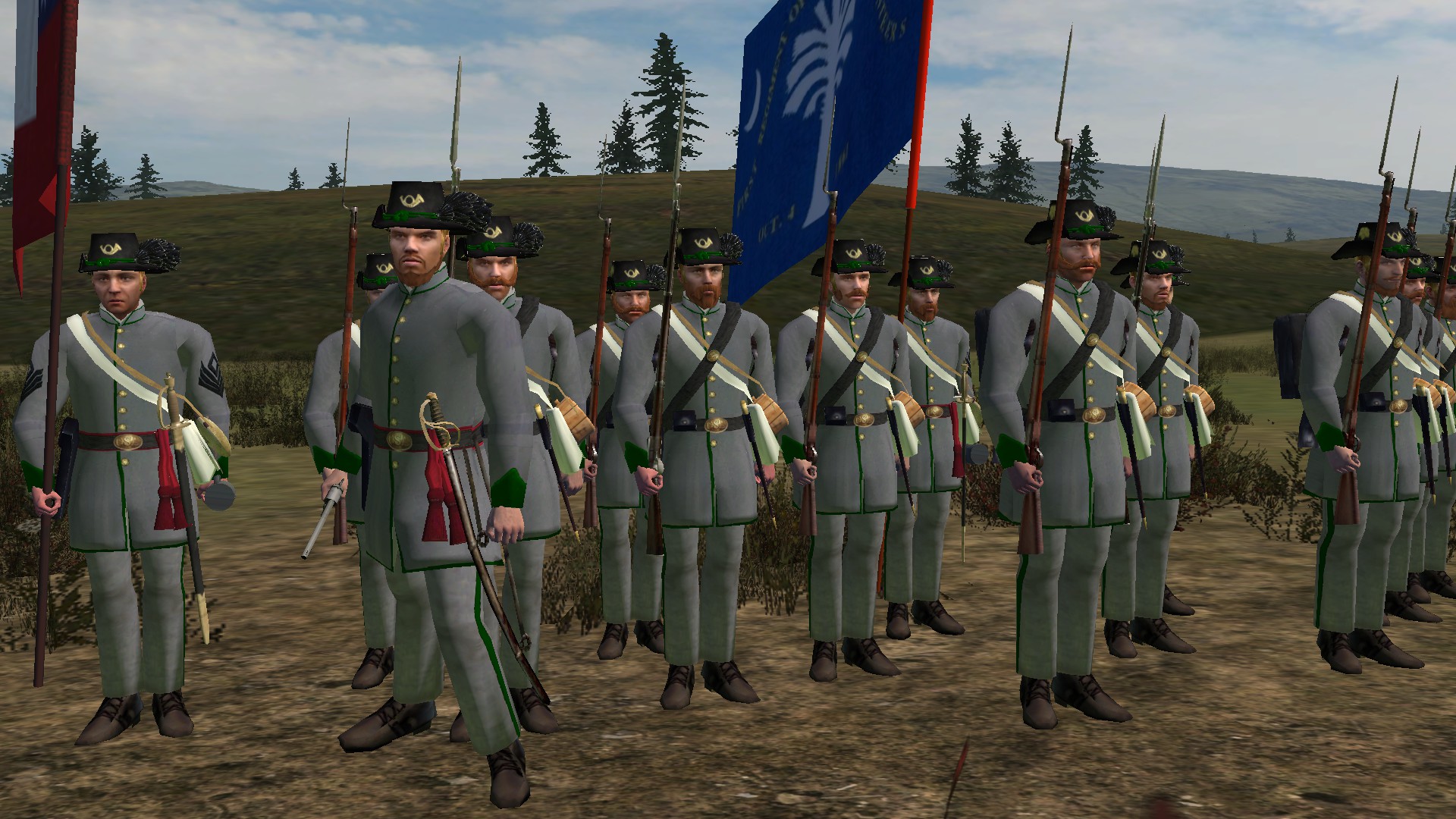
Weapons: (Buck & ball) Springfield Model 1842 Smoothbore Musket, Springfield Model 1835 Smoothbore Musket, Springfield Model 1822 Smoothbore Musket
Faction: Army of Pensacola
Current Commander: Brigadier General Barnard E. Bee
Recruitment Locations: Charleston, Raleigh, Knoxville, Salem, Fort Macon, Fort Fisher, Charlotte, New Bern, Camden, Wilmington, Fayetteville, Winston-Salem, Newport, Hillsborough, Kingstown, Columbia, Sandy Springs, Roanoke Rapids
On July 20th, 1861, James Lawrence Orr organized the First South Carolina Rifle Regiment at Camp Pickens, Sandy Springs, and was elected to be the regiment's colonel. Ten companies were recruited from the counties of Pickens, Abbeville, Anderson, and Marion. Although uniformed in the green trimmed dark blue uniforms of a rifle regiment, the 1st was supplied with smoothbore muskets. The regiment was first posted to Sullivan's Island, South Carolina, to defend Charleston Harbor, and soon others began to call them the "Pound Cake Regiment" in reference to their light garrison duty. Colonel Orr was elected to the Confederate States Senate in December, and on January 29th, 1862, resigned his commission to enter Congress. Lieutenant Colonel Marshall was promoted to colonel, Major Ledbetter to lieutenant colonel and Captain James W. Livingston of Company A to major.
In April 1862, the full-strength 1,000 man regiment was transferred to Robert E. Lee’s Army of Northern Virginia. In June, it was incorporated into Gregg's Brigade, of A.P. Hill's Light Division, of "Stonewall" Jackson Corps. On June 26th, the regiment became engaged at Mechanicsville, where S.C. Reid of Company G fell mortally wounded. The next day, the regiment suffered terribly at the Battle of Gaine's Mill, losing 81 men killed in action, and 234 wounded, of the 537 men engaged. Captain Francis E. Harrison was numbered among the wounded. In August, the regiment lost 116 men defending the Railroad Cut at the Battle of Second Manassas, and Colonel Marshall was killed in the fighting. Lieutenant Colonel Ledbetter took command of the regiment, being promoted to colonel, but was then mortally wounded and would later die on September 1st. Major Livingston took over command, although he was in poor health.
On September 17th, the 1st South Carolina Rifle Regiment become involved in the Battle of Antietam, and Colonel Livingston "fainted from the heat" and was forced to give up command to Lieutenant Colonel James M. Perrin. From the brigade marker on the Antietam battlefield:
"Gregg’s Brigade formed line about 3 P.M. in the fields southwest of this and advanced into the southwest corner of the 40 acre cornfield, about 100 yards east of this point, where it encountered and repulsed the advance of the extreme left of the Ninth Corps. An effort to pursue into the field beyond was checked, and the Brigade fell back to the line now marked by this road, where it remained until the early morning of the 19th, when it retired to Blackford’s Ford and was the last Infantry Brigade of the Confederate Army to recross the Potomac."
Due to the poor condition of his health, Colonel Livingston resigned on November 12th. Lieutenant Colonel J.M. Perrin was promoted to colonel, Major Norton to lieutenant colonel and Captain Francis E. Harrison of Company D was promoted to major. The regiment lost 170 men at the Battle of Fredericksburg in December, when Union troops broke through the lines and surprised the South Carolinians resting under stacked arms. Lieutenant Colonel Norton was wounded, losing his left arm, and Captain James T. Robertson was also wounded. General Gregg was killed, and Samuel McGowan took over command of the Brigade. On March 25th, 1863, Lieutenant Colonel Norton resigned due to his wound from Fredericksburg. Major Harrison was promoted to lieutenant colonel and Captain George M. Miller of Company G was promoted to major.
In the first days of May, 1863, the 1st South Carolina Rifle Regiment became hotly engaged at the Battle of Chancellorsville and suffered terrible casualties. The regiment lost 49% of 233 men engaged, including General McGowan who fell wounded. Colonel Perrin took command of the brigade, but was mortally wounded on May 3rd. Lieutenant Colonel Francis E. Harrison took command of the regiment, and on May 5th, Colonel Perrin died of his wounds. Lieutenant Colonel Harrison was promoted to colonel, Major Miller was promoted to lieutenant colonel and Captain John B. Moore of Company L was promoted to major. In July 1863, the 1st South Carolina participated in the Battle of Gettysburg, losing 3% of the 366 men engaged. From the monument to Perrin’s Brigade on the Gettysburg Battlefield:
"July 1. Crossed Willoughby Run about 3:30 P. M. with its left in Reynolds Woods and advancing relieved Heth’s line. Took a prominent part in the struggle by which the Union forces were dislodged from Seminary Ridge and pursuing them into town captured many prisoners. The Rifle Regiment was on duty as train guard and not in the battle of this day."
On the second day of the battle, the regiment supported artillery south of Fairfield Road, and at 6:00 P. M. advanced a battalion of sharpshooters, which skirmished with Union outposts until dark. At 10:00 P. M. the regiment took position on Ramseur’s right in the Long Lane leading from the town of Gettysburg to the Bliss House and Barn. On the third day, the regiment was in the same position and constantly engaged in skirmishing. On July 4th, the regiment withdrew after nightfall and began the march to Hagerstown. The regiment was present for the Battle of Falling Waters on July 14th, and on August 28th, Major Moore resigned due to ill health and Captain William H. Hadden of Company A was promoted to major. The regiment participated in the Bristoe and Mine Run campaigns, and on April 7th, 1864, Colonel Harrison retired to the Invalid Corps. Lieutenant Colonel Miller was promoted to colonel, Major Hadden was promoted to lieutenant colonel and Captain Leonard Rogers of Company C was promoted to major.
The regiment lost 12 killed and 81 wounded at the Battle of the Wilderness in May, and at the Battle of Spotslyvania Court House, the regiment lost 15 men killed, 36 wounded and 44 missing, including Colonel Miller. Major Leonard Rogers was captured on May 12th. From the monument to McGowan’s South Carolina Brigade at the Bloody Angle:
"In the rainy gloom of May 12, 1864, Brigadier General Samuel McGowan’s brigade of South Carolinians battled their way into the disputed earthworks here, near the apex of the Muleshoe Salient. For eighteen hours the 1,300 South Carolinians defended these works against relentless attacks by thousands of Federals, sometimes engaging in hand-to-hand fighting. By battle’s end, 451 men of the brigade were killed, wounded, or missing. The slight angle in the works they defended would forever be known as the Bloody Angle."
At the Battle of Poplar Springs Church, the 1st South Carolina Rifles lost 9 men killed in action and 37 wounded. The regiment went on to fight at Cold Harbor and Deep Bottom, where the regiment lost 3 men killed, including Lieutenant Colonel William H. Hadden, and 34 wounded. Major Robertson took command of the regiment and was promoted to lieutenant colonel. The regiment fought it's last battles at First Squirrel Level Road and Jones' Farm, First Pegram’s Farm, Gravelly Run, and Five Forks. Colonel George M. Miller was captured at the Battle of Dinwiddie Courthouse on April 2nd, and on April 9th, 1865, Robert E. Lee surrendered the Army of Northern Virginia, including Orr's Rifles, at Appomattox Court House. After three years of combat, the 1st South Carolina Rifle Regiment comprised 9 officers and 148 enlisted men.
Hagood's 1st South Carolina Infantry "Edisto Rifles"
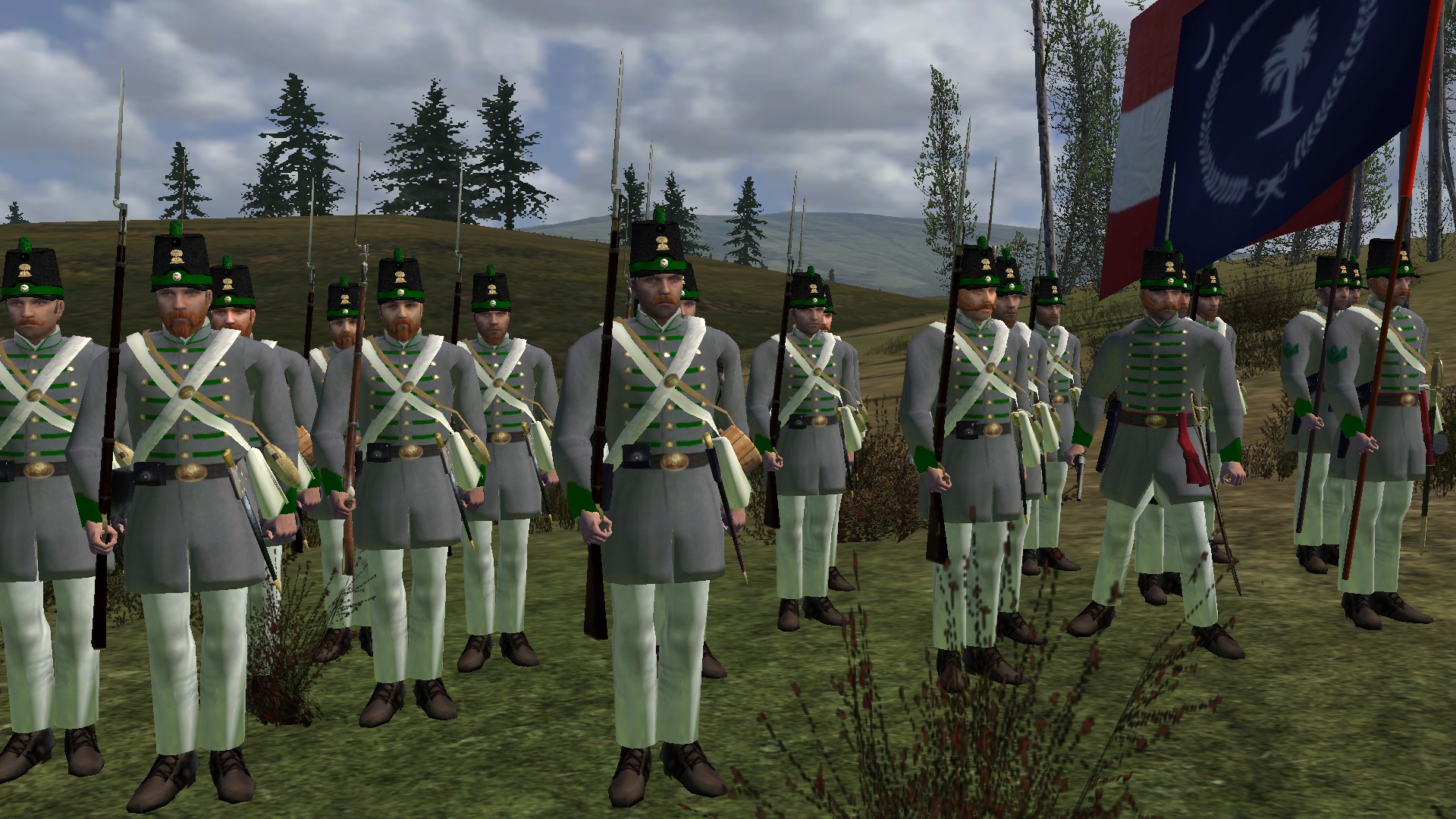
Weapons: Pattern 1853 Enfield Rifle Musket
Faction: Army of Pensacola
Current Commander: Major General David Rumph Jones
Recruitment Locations: Charleston, Raleigh, Knoxville, Salem, Fort Macon, Fort Fisher, Charlotte, New Bern, Camden, Wilmington, Fayetteville, Winston-Salem, Newport, Hillsborough, Kingstown, Columbia, Sandy Springs, Roanoke Rapids
Hagood's 1st South Carolina Infantry Regiment completed its organization at Barnwell, South Carolina, in December of 1860, and entered Confederate service in April, 1861. Its companies were raised in Charleston and the counties of Orangeburg, Lancaster, Barnwell, Greenville, Colleton, and Richland. The regiment served in the Department of South Carolina, Georgia, and Florida, and first saw action at the Battle of Secessionville under the command of Lieutenant Colonel Thomas J. Glover. The 1st South Carolina moved to Virginia and was attached to Jenkins’ Brigade of Kempers’ Division. On July 12th, Colonel Hagood was promoted to brigadier general . Lieutenant Colonel Thomas J. Glover was promoted to colonel, Major Duncan was promoted to lieutenant colonel, and Captain Daniel Livingston of Company B was promoted to major.
From August 29th to the 30th, the 1st South Carolina was engaged at the Second Battle of Manassas (Bull Run), where Colonel Glover was mortally wounded in the leg and abdomen, and Major Livingston was wounded. The regiment was present for the battle of Chantilly on September 1st, where Lieutenant Colonel Duncan was appointed acting colonel by General Micah Jenkins, Major Livingston was promoted to lieutenant colonel and Captain George M. Grimes was promoted to major. Later in the month, Jenkins' Brigade was reassigned to David R. Jones' Division, under Longstreet's command, and on the 14th of September, the regiment participated in the battle of South Mountain. The regiment was commanded by Lieutenant Colonel Daniel Livingston, losing 1 man killed and 15 wounded, including Colonel Livingston who was wounded during the battle. Colonel Walker, commanding the brigade, reported that Company A refused to advance through the gap and enter the fight.
On September 17th, the 1st South Carolina participated in the Battle of Antietam. The regiment was commanded by Lieutenant Colonel Daniel Livingston, who was still suffering from the wound he received at South Mountain. From the brigade marker on the Antietam battlefield:
"September 15-17, 1862
Jenkins’ Brigade reached Sharpsburg at 11 A.M. September 15th, and took position on the high ground west of the Cemetery. Late in the evening it moved to the high ground west of the Burnside Bridge Road, where it remained under artillery fire until 3 P.M. of the 17th, when it returned to its first position in support of Moody’s and Squire’s Batteries.
It then advanced to the apple orchard and to the stone house and mill, about 250 yards north of this point, where it engaged the Federal line, which had reached this elevation. After the withdrawal of the enemy, the Brigade advanced its skirmishers over this ground to the crest of the hill overlooking the low ground and a belt of woodland bordering the Antietam. The Brigade was relieved by Fitzhugh Lee’s Cavalry Brigade during the night of the 18th and at sunrise of the 19th crossed the Potomac at Blackford’s Ford."
Out of the 106 men who entered the fight 4 men were killed and 36 wounded. At the end of the day only 1 officer and 15 enlisted men remained on the field, for which they were harshly criticized by their brigade commander, Colonel Walker.
On the 20th, the regiment was engaged at the Battle of Shepherdstown, and in November, Jenkins' Brigade was assigned to Pickett's Division, with Longstreet's First Corps. On December 13th, The 1st South Carolina lost one man at the Battle of Fredericksburg. On January 10th, 1863, Lieutenant Colonel Duncan resigned his commission after the War Department refused to confirm his appointment to colonel. Major Franklin W. Kilpatrick of the Palmetto Sharpshooters was appointed colonel of the 1st South Carolina on January 31st, after an application by the regiment's officers. From March through May, the regiment participated in the Suffolk Campaign, and in June through July, participated in the Gettysburg Campaign, however, Jenkins’ Brigade was detached in Virginia and was not present for the Battle of Gettysburg.
The regiment was present for the Battle of Falling Waters on July 14th, and in September, Jenkins' Brigade was assigned to Hood's Division of Longstreet's First Corps and transferred to the Army of the Tennessee. The 1st South Carolina fought at the battle of Wauhatchie on October 28th, and Colonel Kilpatrick was killed in action during this engagement. From November through December, the regiment participated in the Siege of Knoxville. On November 16th, Captain James R. Hagood of Company K was promoted to colonel. James was only 18 years old and the brother of Johnson Hagood, the regiment’s first colonel.
In February 1864, Jenkins' Brigade was assigned to Field's Division of Longstreet's First Corps, and in mid-April, the regiment returned to Virginia with Longstreet's two divisions. From May 5th to the 6th, the 1st South Carolina fought at the Battle of the Wilderness, and Brigadier General Micah Jenkins was mortally wounded in the fighting. Colonel John Bratton of the 6th South Carolina took over the brigade as senior colonel, and Captain George Grimes was also wounded during this engagement.
From May through June, the 1st South Carolina fought at The Bloody Angle in the Battle of Spotsylvania Courthouse, suffering 22 casualties out of 169 men engaged, as well as the battles at North Anna, Jericho Ford, Cold Harbor, and the Siege of Petersburg. On June 27th, Colonel Bratton was promoted to brigadier general and given permanent command of the brigade. From September 28th to the 30th, the regiment was engaged at the Battle of Fort Harrison/New Market Road, where Captain Grimes was mortally wounded. On October 7th, the regiment lost heavily at the Battle of Darbytown Road in a charge against Union infantry armed with repeating carbines. The regiment was engaged once more at the Battle of Williamsburg Road on October 27th. From June 13th to December 31st, the 1st South Carolina lost 17 men killed, 89 wounded, and 17 missing. On April 9th, the regiment surrendered at Appomattox Courthouse with 21 officers and 201 enlisted men present.

